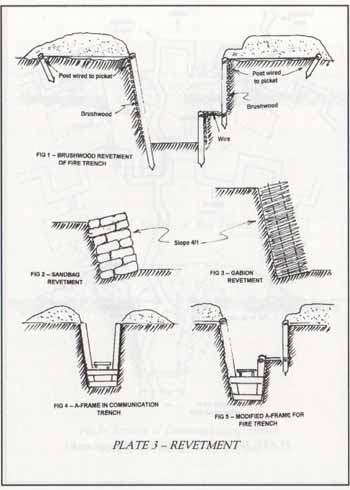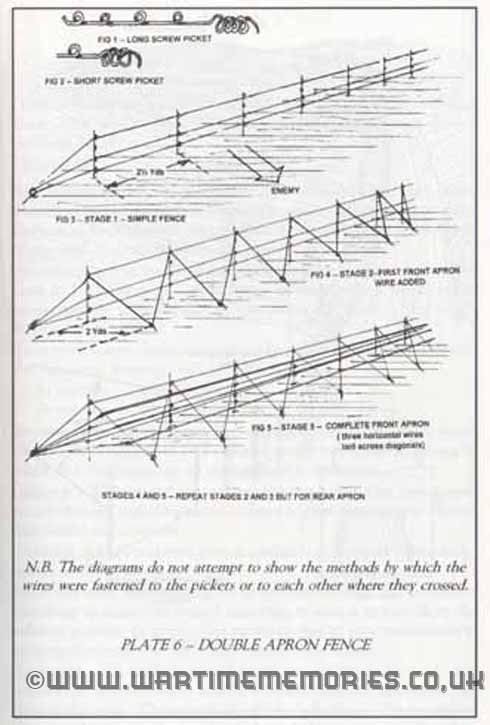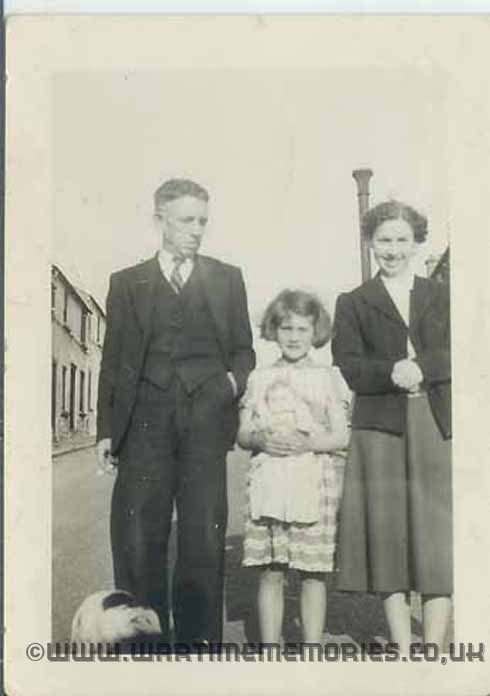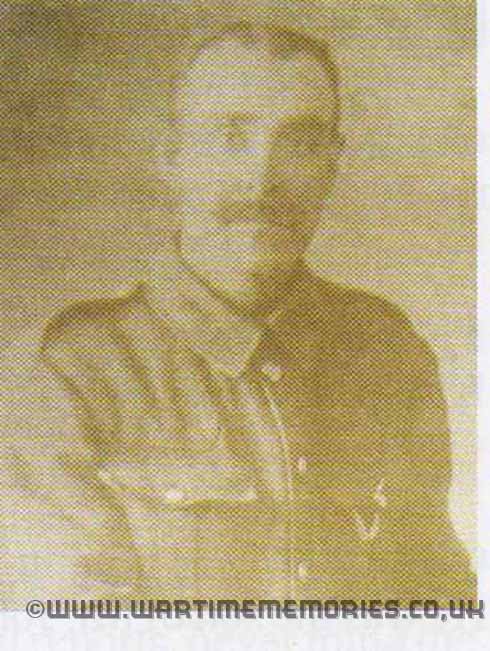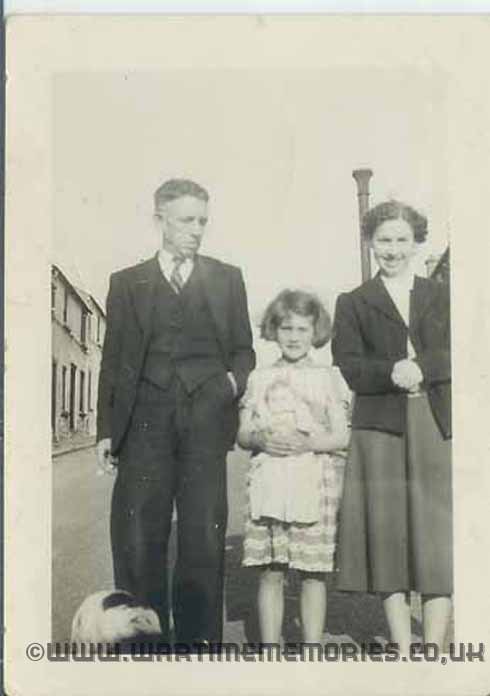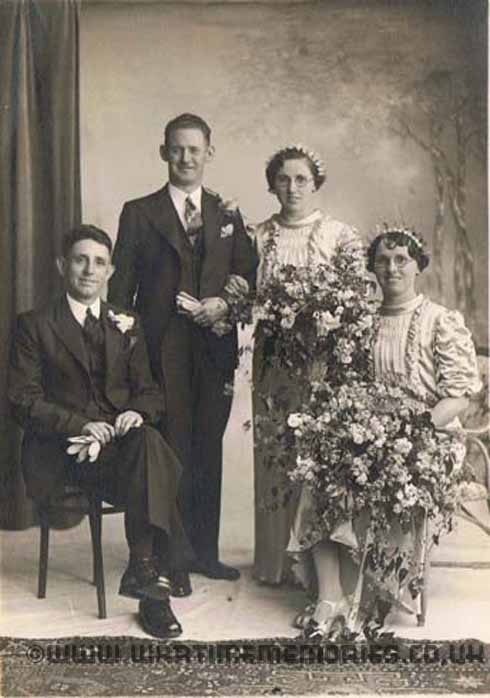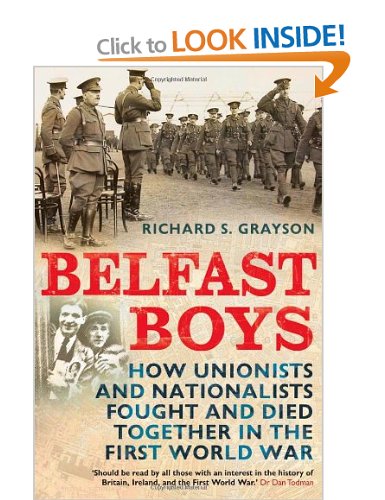109th Trench Mortar Battery (from 1 April 1916).
1st November 1914 Pioneering Work 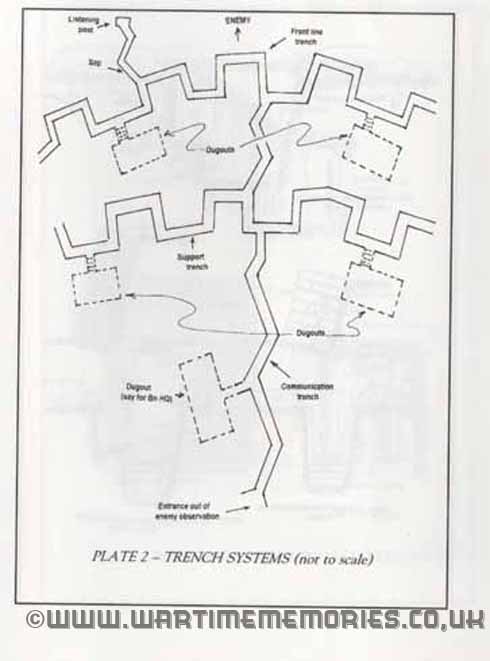
Typical Trench System Layout (Not to scale)
16th Bn Royal Irish Rifles (Pioneers)'
Reader guidance note:There are entries on 2,3,4,5 and 6th November 1914.
Trench Warfare in WW1.
After the initial assault by Germany was finally halted, the remainder of the war was fought from entrenched positions on both sides.
Basically the two Front Line trenches faced each other from varying distances. They were not in straight lines as firing along the trench by the enemy would have had catastrophic consequences, rather in zigzag formations making a continuous line to adjoining defences - either a physical barrier or a neighbouring military unit.
So for years the trench positions continuously changed hands as battles were won or lost. In particularly bad weather this led to virtual seas of mud in what was termed "No Man’s Land" from the combination of weather and artillery shells.
Behind the Front Line trench were supporting trenches similarly fashioned and linked by communication trenches. Dugouts to provide safe shelter were provided in strategic areas together with strong points such as machine gun and mortar emplacements.
Trenches were further protected by Wiring in front. This was basically lines of barbed wire to hold back attacking forces.
Trenches were initially dug to existing old military manuals, but from early experience were found to be too shallow and too narrow for the rapid movement of supplies and equipment, so a lot of work would be needed in widening and deepening the earlier trenches.
Other trench works included:
Revetment, which is lining the sides of a trench with padding materials ( to help protect from back-blast from exploding shells) which could be sandbags, timber or earthworks and in some cases concrete.
This also included firing steps and duckboards to facilitate drainage.
Dugouts as the name suggest are deep enclosures providing some degree of safety during bombardments.
Saps, these were smaller trenches dug from the Front Line towards the enemy’s front lines. They were used as listening posts or for locating a machine gun or mortar and could also provide a jumping off point for an attack.
Other Structures:
Craters and Camouflet - Another tactic employed was the use of explosives underground to either blow up the enemy trench positions themselves (mines) or disturb ground in no-man’s land exposing craters which could be connected up to their own front line, bringing them closer to the enemy’s front line. Sometimes the explosion would result in an underground cavern (called a Camouflet) which could be worked on under cover from enemy observation and often an initial start to Sapping itself as the surface could be quickly collapsed leaving the Sap ready for use.
Screening - This was simply erecting simple screens alongside roads and other locations which needed to be kept out of sight from the enemy, usually when the enemy occupied higher ground overlooking support and communication rear areas. This was to minimise observation opportunities for snipers or artillery observers.
Pioneer support work in attack or defence:
During an offensive operation the Pioneers would have to turn around the firing positions in captured trenches provided the gains were held. They would also have to join up their former front line with the captured trenches by new communication trenches often using their own saps as starting points closer to the former enemy trenches.
The reverse was also true and if their lines were overrun they would have prepared previous positions for troops to fall back on and if given sufficient time try to render the lost trenches virtually useless to the enemy.
Road works.
Naturally a huge logistic problem was supply of Ammunition, rations and equipment which had to be got to the Front Line troop positions. Roads had to be drained in bad weather, repaired when damaged by explosives, flooding and heavy traffic.
Railways.
Main line railways were vital to forward movement of bulk material, equipment, men and animals over longer distances. However there were also some light, narrow gauge - systems and trench railways. Equipment would be transported by main line railway to large depots from which it would be forwarded by road or smaller gauge light railways closer to the front. It would then be brought through the communication trenches manually or using the trench tramways to the front itself.
The trench railways or tramways involved hauling trolleys through communication trenches to keep the front lines supplied and remove salvage and waste materials on return journeys. They were operated by a party of 6 to 8 men per trolley. It was also used to return casualties to rear areas for treatment. This was the main reason for the extensive programme of trench widening and deepening so that men and trolleys could move freely on tracks out of sight from the enemy though still in danger from enemy artillery if targeted.
2nd November 1914 Recruitment of 16th Btn. Royal Irish Rifles 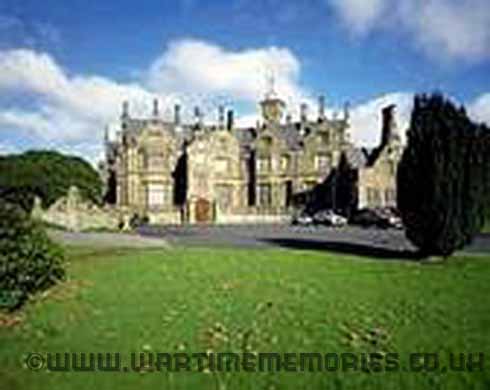
Brownlow House
A second call to arms was published in all County Down Newspapers on
Saturday the 7th November 1914, exhorting all able bodied men wishing to enlist to go to their local railway stations on Monday 9th November, where they would be issued by local UVF Company Commanders with free rail tickets to Lurgan. On arrival in Lurgan, they should then report to Brownlow House for enlistment in the new volunteer Service Battalion. Initially called the Second County Down Battalion, it later took on its official title of the 16th (Service) Battalion, Royal Irish Rifles (Pioneers).
The Battalion adopted the renowned "South Down Militia" as their marching song changing the words as follows:
- "You may talk about th’Irish Guards and Fusiliers of course
- You may talk of Inniskillings and the gallant Irish Horse
- Or of any other regiment under the King’s command
- But the 16th Irish Rifles are the Terrors of the Land."
From which derived their nickname as "The Terrors".
The Battalion strength was to be 1139 all ranks and it was to be a separate unit to support the three brigades in the 36th Ulster Division. This was indeed an early clue as to its specialist role as Pioneers. They were commanded by Major Leader who was promoted to Lieutenant Colonel prior to the move to France. He proved to be a very able leader of his battalion. It was to be organised on the lines of 4 companies of 230 all ranks each, a Headquarters unit of 79 all ranks and a Machine gun section of 35 all ranks. Headquarters could be split into three sections namely Operational Headquarters, Quartermasters and the Transport Section. An additional 50 was later added to Battalion establishment to bring overall strength target to about 1200.
Other key appointments were Sir William Allen, well known in Lurgan as a local Justice of the Peace and a highly placed member of the Orange Order, who was initially appointed as Adjutant and Second- in-Command of the Battalion.
The Quartermaster was Honorary Lieutenant A. Forsyth, who had been a sergeant-major with the Antrim Artillery in Carrickfergus and was promoted for this position.
Other Officers and senior NCOs were appointed as they became available including the author’s father - 2/Lt. WR White. With accommodation and equipment being prepared and assembled at Brownlow House, these and other early appointees were ready to equip and train the awaited recruits.
Recruitment., November 1914 to June 1915.
Recruitment was slow and 250 men were transferred in December from Clandeboye Camp. A series of public meetings were held at which pressure was applied by speakers to encourage or indeed shame men into enlisting to help their compatriots at the Front. Uptake was still quite slow and by the end of January 1915, numbers were about 350 below strength. A series of marches throughout the county by a contingent of 150 officers and men during February helped boost the intake. Other measures were regular inspections by well-known public figures, to which the public were invited as spectators. Despite all these measures the battalion was still short of their 1200 all ranks target in mid-June, so 200 members of the Belfast Young Citizen Volunteers were transferred leaving a full strength of about 1200 prior to the move to England.
Training objectives/
The rigorous task of physical training began in Lurgan and the surrounding areas. A lot of this was in the form of route marches and competitive sports. It then progressed to tactical manoeuvres and mock assaults and defences. This brought the unit to battle readiness as fighting troops with the exception of musketry and machine gun training which because of the lack of live ammunition was to be carried out in England.
3rd November 1914 Pioneering work - trenches 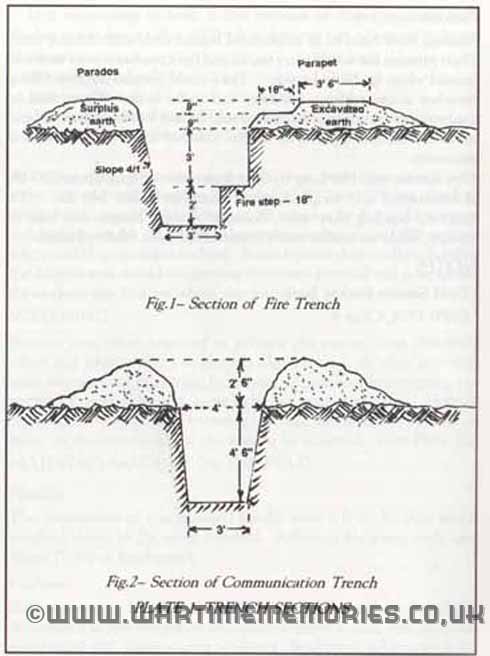
Cross-section of trenches
16th Btn. Royal Irish Rifles - Pioneers
Trenches were typically constructed to provide shelter for forward troops and fell into two general categories.
Fire Trenches as the name suggests were trenches from which the enemy could be engaged in offensive or defensive actions (see cross section in diagram).
Communication Trenches were the means by which men and equipment could move in relative safety to and from the Forward (Fire) Trenches.(see cross section in diagram).
4th November 1914 Pioneering work - trenches 16th Btn. Royal Irish Rifles - Pioneering Work in the Trenches.
Trench Revetment or Revetting is basically the fitting out of the basic trench. The construction depends largely on the geology of the region and the type of ground encountered. Much depends on the surrounding water table levels.
Where water is encountered close to the surface trenches can only be dug to a shallow depth and protection is enabled by building up earthworks, sandbags or even concrete parapets above ground level. This was the problem in Flanders (The Low Country Regions).
In other areas trenches were mainly below ground level up to about 8 feet deep to allow men to walk about out of view from enemy snipers and artillery observers.
Communication trenches mainly required lining with sandbags, timber or concrete to protect against the back-blast from exploding shells.
Fire trenches were more complicated with fire steps needed to get men into firing positions in the event of an enemy attack or help get them out of the trench if they are attacking.
The back of the trench was lined to minimise damage from explosives.
In areas where water ingress was a problem upright timber inverted A-frames were used at intervals to lay duck-boarding leaving a void below the walkway to maintain relatively dry underfoot conditions for movement through the trenches.
(see diagram for cross-sections of revetment work.)
5th November 1914 Pioneering work - trenches 16th Btn. Royal Irish Rifles (Pioneers) - Trench Wiring Work.
A vital tactic to deter enemy attacks was the positioning of rows of Barbed Wire around the top of the trenches. It was merely a small deterrent as it was vulnerable to artillery fire with batteries engaging in "Wire Cutting" either to disrupt enemy work or to clear a way through for assault purposes.
The amount of equipment needed presented many a challenge to the Pioneers particularly during attacks and modifications needed if the infantry managed to hold new forward positions, involving a thousand or more yards of wiring overnight in areas targeted by enemy artillery.
A typical 1000 yards of fencing needed:
- 400 long pickets
- 800 short pickets
- 180 coils of barbed wire (65 yards each)
- 40 coils of barbed wire (130 yards each)
This could be erected by a company of men in about an hour, but the time and effort to get it to the new position and laid out for installation is enormous.
Pickets were screwed into the ground as the work had to be carried out in near silence at night so as not to alert the enemy.
6th November 1914 Pioneering work - screening 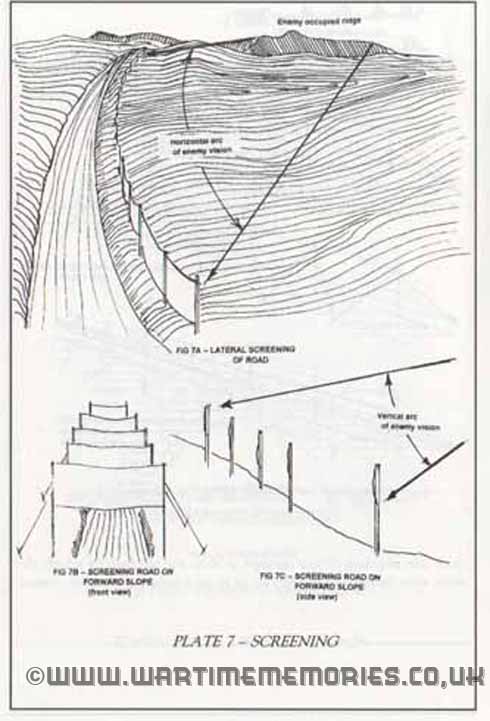
Pioneering - Screening Work
16th Btn. Royal Irish Rifles (Pioneers) - Screening Work.
As the title suggests the object of this work was to disrupt the enemy's line of vision if they occupied higher ground. This was very much the case in Flanders near Mount Kemmel and in preparation for the Battle of Messines Ridge.
From the Ridge the Germans had a commanding view of both Front and Rear Allied positions and it was essential to hide the meticulous build up for the Allied attack.
So all roads and important locations had to have screens installed on the enemy side to conceal troop and equipment movements.
Screens were made from light equipment, wooden poles and mainly hessian materials to a height sufficient to obscure the enemy's view of traffic on roads, movement in and out of buildings and movement of men and equipment in the assembly, communication and assault trenches.
23rd of November 1914 Reorganisation
1st December 1914 Recruitment and Training 16th Btn. Royal Irish Rifles.
Recruitment efforts continued and helped raise Battalion strength from 230 at the end of November to 500 by the 19th December 1914.
Training began to bring recruits up to the physical requirements for battle fitness with physical exercise and route marches of increasing intensity. A large batch of service rifles arrived on the 19th December which meant that military weaponry drill could be incorporated within the training timetable. Route marches got longer and, on the 7th December, the men marched to Banbridge and back (16 miles) in 3 ½ Hours.
Initially training would have concentrated on infantry skills including drill, musketry, bayonet fighting and training in the Lewis and machine guns. Route marches and PT (Physical Training) would also have featured. Selected Officers and NCOs on appointment were sent to infantry training schools to become instructors in these fields. A rifle range was constructed at the rear of Brownlow House. The pioneers were basically riflemen and in the Royal Irish Rifles had to learn to drill at "rifles pace" which was 160 paces to the minute as opposed to the normal infantry rate of 120 paces to the minute. Field-craft with elementary infantry tactics at section, platoon and company level were gradually introduced as potential section leaders were identified, trained and gained in confidence and experience.
Jan 1915 Specialist Training
19th January 1915 Recruitment and Training 16th Btn. Royal Irish Rifles 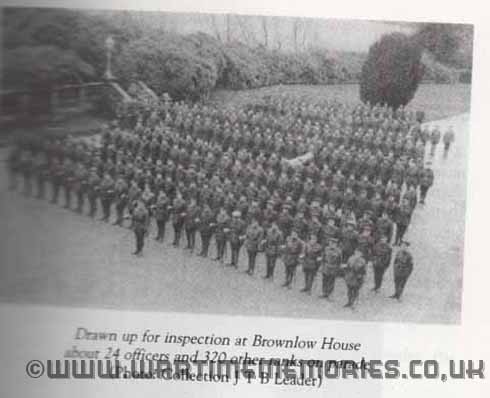
Parade at Brownlow House, Lurgan.
16th Btn. Royal Irish Rifles - Pioneers
Recruitment continued making slow progress with numbers reaching 800 all ranks by the 19th January 1915.
Training continued in various stages as more recruits joined and had to work hard to catch up with the standard of earlier enlisted ranks. There was little sympathy for newer recruits who had to catch up with the others. The young animal must keep up with the herd in migration or else - so time was not on their side.
Early in January it was announced that the 2nd County Down Volunteers were to become the Pioneer Battalion for the Ulster Division. Training in pioneering skills was to commence while maintaining physical fitness and military discipline. There was now more concentration on manoeuvres at both day and night trying to gain experience in mock attacks and defence methods before the real battles ahead.
That would have left the battalion ready for normal action but this was not a normal battalion. Alongside this training they now had to learn the skills of the pioneer which involved all aspects of transportation in offensive and defensive positions including river crossings. Afternoon classes taught joinery and other skills for battle planning. Sections were sent by rotation to work on local roads, railways and buildings all of which they would have to service under enemy fire in the front line areas in France and Belgium.
In recognition of their additional duties they were to be paid an extra 2 pence a day on top of the infantry rate of one shilling per day. It was later raised in parliament that this compared unfavourably with the Royal Engineers who received 1/10d per day and the Labour Corps which received 3 shillings per day. Even though it was like work the government refused to interfere with what it termed as set army rates of pay.
An article entitled trench warfare has been included in November 1914 pages which, with relevant sketches, details the type of construction carried out with some description of offensive and defensive related works.
(These appear in the date range 1st to 6th November 1914.)
So the 16th were a very special unit indeed as we shall see from their performance up to and after the cessation of hostilities in 1918.
On the 12th January 21 horses arrived and the Transport Officer got to work on his teams for transporting equipment necessary to support the men in their work locations. Certain officers were also required to have mounts to fulfil their command roles.
Railway Training.
On the 21st January 4 Officers (including 2/Lt. White WR, the author's father) and 50 men were sent to Belfast, Carrickfergus and Antrim to receive instruction on Railroad Construction.
A similar party of 4 officers and 39 men were sent to Newtownards for pioneer railway work. It seems likely that Antrim had a Royal Engineer Field Unit which would have helped considerably in the training.
1st February 1915 Recruitment and Training 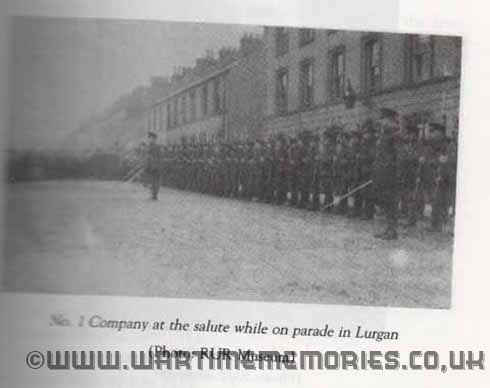
16 RIR parade in Lurgan, County Armagh.
16th Btn Royal Irish Rifles - Pioneers
Recruitment tour of County Down.
In order to try and boost intake a recruitment tour of County Down was organised, starting on the 15th February and ending on the 27th February, with 150 Officers and men under the command of Major Gardiner and including the newly formed pipe band. It was followed by 2 horse drawn wagons and a horse drawn field ambulance unit.
The schedule was as follows:
- February 15 Dromore
- 16 Ballynahinch
- 17 Dromara
- 18 Saintfield and Crossgar
- 19 Downpatrick
- 20 Clough, Seaforde and back to Downpatrick
- 21 Downpatrick
- 22 Comber via Killyleagh and Killinchy
- 23 Donaghadee via Newtownards
- 25 Comber via Bangor
- 26 Hillsborough
- 27 Lurgan via the Maze, Moira and Maralin.
In each location a marching display would be followed by meetings and speeches after which the troops would be fed, entertained and accommodation provided by locals. The success of this recruiting march is difficult to assess as the strength figures were reported less frequently.
Training.
Interspersed with infantry training, the emphasis now switched to pioneering skills in trench, road and railroad construction
Trench works.
Trenches were constructed in readily available countryside locations and used to replicate known offensive and defensive methods. It was hard manual work as there were no mechanical machines. So, as practice, 5 foot deep by 1 ½ foot wide trenches were literally dug out by pickaxe, shovel and hands, hard labour by any standards in a peaceful country environment. How much more difficult it must have been in hard ground or muddy conditions, good and bad weather, with hostile fire from sniper, machine gun or artillery and with much deeper and wider dimensions.
Wiring techniques were also taught in conjunction with the trench layouts.
It is doubtful that full fitting out of trenches took place as materials were in short supply. (Revetment or revetting).
Road works.
On the 8th February 2 officers and 50 other ranks left for Keady where they assisted County Council men in constructing a new roadway at Drumderg nearby. They returned on the 17th and Armagh County Council donated £10 towards comforts for the men in appreciation of their work. Work was also carried out at the rear entrance to Brownlow House, widening the Avenue Road and constructing a new walkway in the park.
Railway Training
Again 4 officers and 50 other ranks left on the 3rd February for Skerries, Co Dublin for instruction in pioneer railway work.
1st March 1915 Recruitment and Training 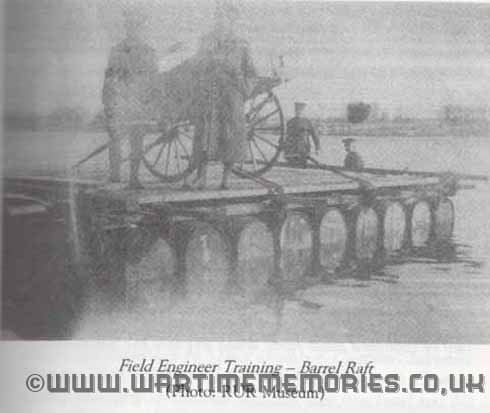
Bridging Training near Lurgan, County Armagh.
16th Btn. Royal Irish Rifles - Pioneers
Recruitment figures were not published for March 1915.
Recruitment efforts were mainly concentrated on Brownlow House as a showpiece for many inspections by high ranking officers and politicians, the public also in attendance.
Training.
Much more intensive military manoeuvres took place by night and day increasing the demands on all officers and men to harden them for future demands on active service.
Trench works.
During the week ending 20th March the Battalion carried out several very interesting operations including day and night outpost schemes with trench digging and sapping by night. Sapping is cutting out trenches from the front line forward towards the enemy trenches, used for listening posts, mortars, machine guns or jump off points for attacks.
Road works.
Work continued on projects with local councils alongside council workers in County Armagh and County Down.
Railway works.
A great deal of railway training was undertaken in March.
On the 21st March 3 Officers and 7 NCOs were sent to Crumlin, where a railway bridge was being erected.
Other works were carried out on the rail lines near Antrim, on the Lurgan to Moira railway line and a course was attended at Stewartstown.
Bridging.
While it is not recorded what types of bridging works were done, we can assume they had to construct bridges capable of taking Divisional Horse drawn transport including artillery pieces.
There were various exercises carried out on lakes in local parks and bridge building on the Lagan near Donacloney and Dynes Bridge. Barrel rafts capable of supporting wagons and artillery pieces were constructed.
Demolition.
Training in explosive and demolitions was limited from a practical point of safety and shortage of materials. Demonstration of grenades, land mines and the use of gun cotton on rocks and metal were done with reduced charges leaving the observers to imagine the effects of a full charge.
They were also introduced to jam pot type grenades and the use of warning flares including methods of firing; trip wire, cut wire and pull by defender. Other examples included explosive traps already experienced in early fighting at the Front.
General Field Training.
There is no evidence to suggest that any form of formalised field training was available prior to leaving Lurgan and that progress in this area would be based on ad hoc solutions devised in training exercises or live situations. There is evidence of training courses being held at Reading in Berkshire.
1st April 1915 Recruitment and Training 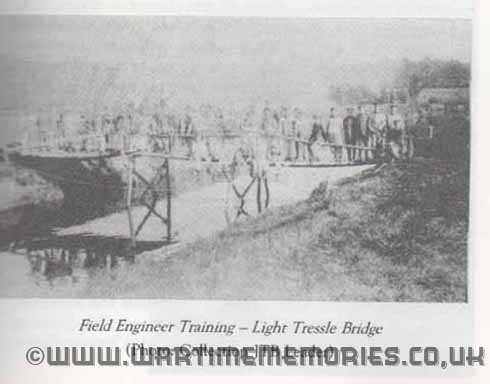
Bridge training work near Lurgan County Armagh
16th Btn Royal Irish Rifles - Pioneers
Major Leader was promoted to Lt.Colonel.
Recruitment resulted in Battalion strength of 971 on the 17th April 1915. Other houses in Wellington Street were acquired for accommodation purposes as Brownlow House capacity was reached.
Training continued in areas demanding greater stamina in general field-craft exercises involving units in offensive and defensive roles. This included some larger scale exercises with the Ulster Division as a whole.
The whole Battalion took part in route march to Portadown on the 3rd April.
Road Works.
Continuing work in County and District areas including drainage and sewer systems together with building and construction works.
Railway Work
2 officers and 20 other ranks helped the Great Northern Railway when a stretch of about a mile of track was re-laid between Dromore and Hillsborough.
3rd April - 2 officers and 5 men went to Stewartstown for a Railway Engineers Course.
10th April - attended railway bridges installations at Adelaide and Windsor.
17th April, 2 officers and 18 men sent to Crumlin for railway bridge building.
1st May 1915 Recruitment and Training 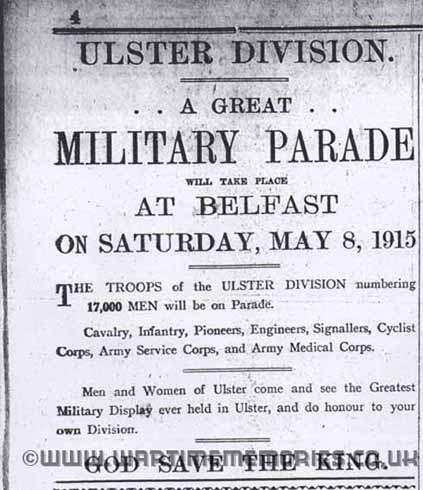
Belfast Parade 36th Ulster Division - 8th May 1915
16th Battalion Royal Irish Rifles (Pioneers)
Recruitment figures not published and Training continued to improve both infantry and trade efficiency.
150 men took part in preparation of the ground for the Grand Parade by the Ulster Division in Belfast on the 8th May 1915.
The 36th (Ulster) Division was drawn up at noon on the 8th May in review order at Belfast, between the Lagan and Malone, for inspection by Major General Sir Hugh McCalmont and then marched into Belfast where the salute was taken again by Sir Hugh, The Lord Mayor and Lady Mayoress, Sir Edward and Lady Carson, Sir George and Lady Richardson and the City High Sheriff with his wife at the City Hall.
The 16th (Service) Battalion Royal Irish Rifles (Pioneers) brought up at the rear of the column.
They travelled to and from Belfast by special train from Lurgan.
1st June 1915 Recruitment and Training 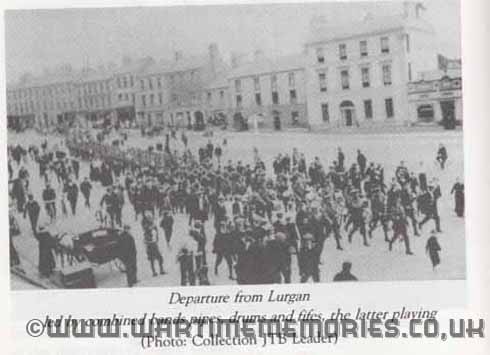
16 RIR Departing from Lurgan enroute to England.
16th Btn. Royal Irish Rifles - Pioneers.
Recruitment was brought up to the required total by the transfer of 200 members of the Belfast Young Citizen Volunteers.
Training was nearly complete and preparations were in hand for the move to England.
Officers and men were sent to Belfast and Dublin for courses on Railway Transport and Embarkation obviously with a view to organising the Battalion’s planned movements which would include both rail and ship embarkation and disembarkation.
All the men were given 4 days embarkation leave and returned fit and ready for the move to England.
A Military Gymkhana was held in Lurgan with over 25 events many of which were novelties giving great amusement to all onlookers.
1st July 1915 Relocations 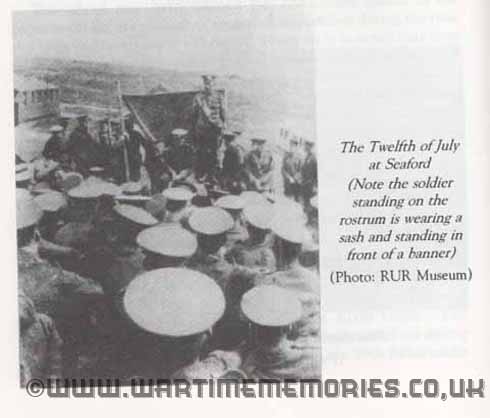
Twelfth July celebrations at Seaford County Sussex.
16th Btn. Royal Irish Rifles - Pioneers.
The Move to England.
This was well reported in the Lurgan Mail issue on the 10th July 1915 which read:
"The secret about the move on Sunday night 27th June leaked out that the first contingent was to move off on the following morning and early on Monday everyone was alert. There was much stir and bustle at the barracks, but it was not until half past two o’clock p.m. that a move was made. At that hour preceded by both bands of the battalion, 170 of the riflemen swung round Windsor Avenue corner into Market Street and proceeded to the Railway Station in command of Captain Jewell and several Lieutenants. Soon the streets were crowded, the route to the station being lined by friends and admirers, and many were the leave takings as the men passed by, many were the greetings and good wishes shouted to them. The public were wisely excluded from the station premises, but the footbridge and every vantage point was crowded. The leave taking on the platform over, the men quickly entrained and the train departed southward amid salvos of cheers from the onlookers. The destination was understood to be Dublin but it has since transpired that the party proceeded the same evening to Liverpool en route for the Seaford Camp.
The next move was made on Tuesday, when the Transport section with their horses, mules and equipment, and in command of Lieutenants White (TJ) and Johnston proceeded by road to Belfast en route, via Liverpool, for the new camp.
Wednesday evening following saw a grand parade of the remaining men of the Battalion with their several officers, through the principal streets of the town, as the farewell march of the regiment in the district, and on Thursday afternoon the entire remaining force moved out in two sections, the first being in command of Colonel Leader and the second of Major Gardiner, two trains being required for their accommodation. The farewell demonstration of Monday was repeated, but on a scale of greater magnitude. All work was temporarily suspended in the town and district, and the line of march from Windsor Avenue to the railway station was crowded with a dense throng. The same arrangements were in force at the station and the entraining was carried out with expedition. Then came the last goodbye of those privileged few who had gained access to the platform and each train was followed by the cheers and kindly wishes of the onlookers"
Seaford, County Sussex.
Finally they were on their way to the south of England and the small town of Seaford in Sussex (not to be confused with Seaforde, County Down, spelt with an ‘e’ at the end!). Seaford had a population of about 4,000 at that time.
For the first time apart from the review and march past in Belfast, the 36th Division was concentrated in one place. It was within walking distance of Brighton with its shops and attractions. Only 20 miles away across the English Channel was the coast of France and, when the wind was blowing in the right direction, the sound of heavy artillery fire could be heard.
The Division was accommodated in the North and South Camps with the Pioneers in the latter. To the north of the camps was the Downs whose rolling valleys and hills provided an excellent area for military training. The first priority was musketry training which was carried out at a range close to the camp at Cuckmere Haven.
The River Cuckmere provided a good site for bridging practice within a quarter of a mile from its entry to the sea. The Pioneers had to contend with a lack of proper equipment and the ebb and flow of the tide.
Despite the urgency for battle readiness they were able to celebrate the 12th July with a parade, entertainment and guests from home. Several inspections took place early in July and on the 20th Lord Kitchener paid a surprise visit. The unit impressed Lord Kitchener who thought them very smart and ready for action, but it was pointed out they had not yet had musketry and machine gun training. He ordered this to be prioritised and it was partially completed at nearby ranges beside Cuckmere Haven.
1st August 1915 Training and recreation 16th Btn. Royal Irish Rifles - Pioneers.
The Downs were fully utilised for Divisional training exercises with the Pioneers acting as the enemy in day and night exercises of increasing intensity. Sport and training courses were also intensified in final preparation for the move to the Front.
There was a meeting of the Pioneer’s Masonic Lodge No. 420 which had been granted a travelling warrant at its inaugural constitution in Lurgan Masonic Hall.
There was also a visit by Sir Edward and Lady Carson on the 3rd August at which everything was declared to be in good order.
The Battalion’s stay on the Downs came to an end as an advance party moved to Borden on the 31st August and an advance Divisional Command Group including General Nugent and Colonel Leader paid a short familiarisation visit to France.
1st September 1915 Training and move preparations 16th Btn.Royal Irish Rifles - Pioneers.
The comfort and scenic stay near the Downs and Sussex villages came to a close at the end of August when the whole 36th Division moved to Bordon and Bramshott . This was mainly to allow the Division the use of numerous ranges in the area to complete their weapon training with live ammunition including bombing, mortars, Lewis and machine guns.
During the month most men got 4 days home leave and all returned to the battalion fit and ready for action.
Colonel Leader, back from his visit to France, was pleased to note that the Battalion’s training had covered most of the requirements for active service.
Finally most of the "comforts" gathered from friends at home, were distributed to the men for the winter season ahead.
So the Battalion consisting of Headquarters and four companies was now ready for the move to France, there to be tested in extreme conditions, in which their training and sense of comradeship would enable them to maintain their discipline and military bearing over a lengthy and arduous campaign.
1st October 1915 Relocations 16th Btn. Royal Irish Rifles - Pioneers.
The Move to France.
On the 1st October at 1900 the Battalion left camp at Bordon for embarkation at Southampton but on arrival no one knew anything about it and there was no transport awaiting them. This proved quite a common problem over the next month or so.
They had to eat their rations while further food was sought for them and spend an uncomfortable night sleeping at the docks.
Next day the Empress Queen arrived to take them across the channel. The ship was licensed to carry 600 passengers between Greenwich and London Bridge whereas the battalion was over 1000 strong and the vessel was crossing the English Channel not plying between points in the River Thames. Despite a gale blowing they crossed safely and arrived in Le Havre.
Once again no one knew anything about the unit but it was eventually sent to tented accommodation and a hot meal organised and the men had to dig trenches around their tents as it was raining. Despite an order to move to entrain for the front Colonel Leader insisted the men had their hot meal first.
On arrival at the station it was no surprise that no one was expecting them, but eventually Colonel Leader was informed of an incoming train which would be put at their disposal. Again the CO got his men to a Red Cross canteen and fed before boarding the train. Apparently there was a bit of a commotion at the Red Cross Unit as it was run by Miss Lloyd George, daughter of the Prime Minister (the Home Rule instigator) and the men preferred to go hungry rather than give her any business. So they were directed to the girl serving on the other side of the station "same firm but you needn’t tell them that", was the advice given and the men got their meal.
At 1000 on the 4th October the train left on a 130km journey to Longueau on the outskirts of Amiens, arriving at 1900. As usual they were unexpected and there was no information regarding their destination. Fortunately the CO met an officer from the Division who gave him general directions to Villers Bocage on the Amiens-Doullens Road. They marched on, passing through Amiens, and arrived at their destination around midnight. The war diaries do not reveal any more details of the journey but they must have met a divisional advance party and perhaps one of their own battalion representative possibly one for each of the 4 companies, Headquarters and Transport.
They spent the next 7 days (4th to 11th October) in this village giving them a chance to settle after their journey. They were assigned light carpentry work and built a road for the Casualty Clearing Station.
A Church Service on Sunday 10th October was conducted by Captain A Gibson, appointed by his church in Lurgan as officiating chaplain to the Battalion and who was now billeted with them, but also attended to some other units.
The remainder of the time must have been spent sorting out their tools and equipment together with loads for their pack mules and other transport arrangements for their future operations.
The sound of gunfire was never far away and indeed the village had already been overrun and occupied by the Germans in the initial onslaught before the establishment of trench warfare brought it back under Allied control.
The campaign was soon to start and on 12th October the Battalion marched about 8 miles to be based at Raincheval and camped there to work on an army defence line in that area. This was about 7 miles from the firing line and was in a shocking sanitary state having been taken over from the French.
The village was in a low lying hollow and the men were billeted in barns and other surrounding buildings with an ample supply of straw underfoot. Such was the progress of the pioneer’s work that on 1st November the Battalion regimental canteen, library and reading room were opened. The Officers Mess and Battalion Headquarters were seemingly located in Raincheval Chateau.
The 20th October marked the first anniversary of the founding of the Battalion and was celebrated by a smoking concert at headquarters and smaller events in other detachments. RSM J Gordon sent a very detailed report on the central event to the Lurgan Mail.
On the 21st October the unit was inspected by the Second Army Sanitary Officer and although the war diary does not record his report, again RSM Gordon writing to the Lurgan Mail recorded that "he made a most complimentary report on the sanitation and added that our work should serve as a pattern to the rest of the army". Thus we begin to see evidence of the professionalism and pride in their work by this exceptionally fine Battalion.
Third Army Defence Line 14th October 1915 to 28th December 1915
The Battalion was now tasked with work on the Third Army Defence Line which initially covered a length of about 3,600 yards extending from a position south east of Toutencourt to Creftel Wood.
Half the Battalion under the command of Major Bowen was moved to Toutencourt to cover work in the area of the Raincheval to Vauchelles Road. It was very hard work and an 8 hour day would have exhausted the strongest of men. It must be noted that they had no excavating or levelling machines so everything was done by hand with manual tools.
The ground consisted of heavy clay for a few yards then sand, limestone and chalk.
Work continued every day in the week except for the odd half day for the very important tasks of washing clothes and bathing.
At the same time No 2 Company under the command of Captain SJ Platt was sent to Vignacourt about 5 miles west of Villers Bocage to cut down forest and prepare various timber components for use in the construction of earthwork defences by the rest of the Battalion.
Further sites were allocated on the 20th October.
Small parties were attached in rota to the 8th Bn Royal Scots Fusiliers who were also a pioneer battalion to give the officers and men experience of operations at the front under enemy fire. This gave them experience in erecting barbed wire defences, Wiring as it was termed.
Oct 1915 Reorganisation
12th of October 1915 Instruction
1st November 1915 Pioneering work 16th Btn. Royal Irish Rifles
A Royal Engineers Field Company was placed under the command of No 2 Company, possibly to operate a saw-mill and speed up the supply of timber components for the defence lines. Other work taken on by the Battalion made it necessary to attach a Royal Engineer Signalling Company to No 1 Company under Captain Shepperd to assist with overall communications.
An inspection of work on the 22nd November resulted in further work responsibilities over another 8 miles of trenches in the direction of Toutencourt to Authie and reconstruction of rain damaged trenches near Arqueues.
It was a bitterly cold winter but the work had to continue and the men were issued with sheepskin and goatskin coats (jerkins) which helped in the biting winds. They also built new stables for the transport animals which had to stand out at night.
Snow fell on the 15th November followed by a thaw with melting snow and heavy rain making working conditions much more difficult.
Unlike their comrades in the forward trenches the men could return to warm and dry billets at night.
There was an inspection by the ADMS on the 18th November as concern mounted regarding the health of the men working in such difficult conditions.
(Assistant Director of Medical Services).
On Sunday 28th November the Battalion had a whole day off. It was a fine day and the roads were frost bound and easy for walking so visits to local villages took place in pleasant surroundings.
7th of November 1915 Present Stations
25th of November 1915 Orders
29th of November 1915 Moves Completed
1st December 1915 Pioneering work - trenches 16th Btn. Royal Irish Rifles - Pioneers.
Work continued on various defence areas with 3 Platoon, No 1 Company being sent to Flessells about 3 miles away, to build a large ammunition shed with a concrete base. They also laid 3 metalled roads to and from the site.
Whilst the descriptions make it seem like all work and no play, there were a number of sporting activities that took place including rugby, hockey and soccer matches with neighbouring units. Once again reports on these activity were sent to the Lurgan Mail to help foster morale and boost ongoing recruitment at home in Ulster.
Christmas Day 1915 started off dull and wet, but soon dried up and the sun put in a short appearance. A party was held for the local village children, which helped Entente Cordiale. In the evening both the Pipe Band and the Fife and Drum band performed to finish off the day with stirring tunes. The local priest was invited and must have been the first priest to meet a mainly Protestant Battalion. A few officers tried to converse with him in their limited French. During after-dinner revelry, he enjoyed listening to "The Protestant Boys" asking to hear it several times as it was a very lively tune. He made the fourth request in perfect English by mistake, everyone having wrongly assumed that he would not have understood the words of the song.
Big changes were to follow soon unknown to the festive revellers.
19th of December 1915 Movement Instructions
28th of December 1915 Railway Construction
1st January 1916 Railway Activity 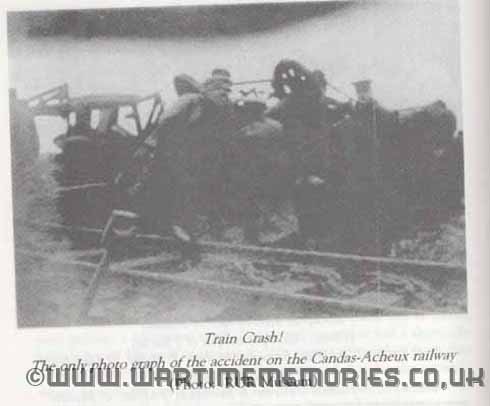
Only Photograph of train crash Candas-Acheux Railway.
16th Btn. Royal Irish Rifles - Pioneers.
Candas to Acheux Railway 28th December 1915 to 31st May 1916.
On the 28th December the 16th Rifles were placed under the direct command of the Chief Engineer, Third Army and tasked with building a broad gauge railway joining the main railway line at Candas to Acheux via Beauval, Punchevillers and Raincheval giving rise to a popular couplet by some Battalion wag:
"The 16th Rifles had nothing much to do
So they had them build a railway from Candas to Acheux."
This was to accommodate a new railhead at Acheux to facilitate the supply of equipment to the Front. Although the decisions on the Somme offensive were not made until March, this early work had in mind an awaited British offensive being demanded by the French to relieve pressure on their positions.
Because of the contours of the terrain and to minimise gradients for heavily loaded trains, what could have been 13 miles of track in a direct line became almost 17 miles.
The railway line supplying this railhead was to be connected to the main Amiens, Doullens line at Candas. Because of the heavy loads to be carried the line was to follow the natural contours in the area rather than crossing them to limit steep gradients. The ground over which it was to be built was mainly rain sodden chalk which greatly added to the difficulty of construction.
The Battalion was deployed as follows:
HQ and No.2 Company to Beauval;
No.3 Company to Fienvillers (just west of Candas);
Half of No.4 Company to Candas;
No.1 Company left to finish off work in Flechelles;
Two platoons of No.4 Company to continue quarrying (ballast for railway).
The manpower requirements were enormous and working parties of unskilled labour were supplied by many units. Everyone working on the railways had to be ready at a moment’s notice to offload trains bringing up materials for the work.
On the 1st January it was stated in the war diary that track was being laid at the rate of 1100 yards per day. The Chief Engineer reported that on the 11th January the track had advanced 3 miles beyond Candas. This was at odds with the reported daily rate of progress but presumably he was referring to completed and fully ballasted sections.
Things were progressing well with a reported 5000 feet laid in a single day, but on the 21st January there was a train crash. The work train was returning when one of the trucks behind the engine jumped the rail at a bad part of the track and two other wagons were smashed. This was a result of having to run heavy trains over un-ballasted sections of track. 2 men were killed and 17 wounded, mostly from other units with only 7 wounded from the 16th Battalion.
A cache of Roman Coins were unearthed between 16th and 22nd January.
On the 22nd January work had progressed so well, despite the crash, that Battalion HQ and Nos.2 and 4 Companies were able to move back to Raincheval.
They were to continue laying track whilst No.3 Company carried on with packing and ballast and finishing the Terminal at Candas, add any necessary sidings and build a large cement tank able to hold 100,000 gallons of water for engines.
No.1 Company moved from Flesselles to Acheux where it was to build the Terminus there, a number of sidings and a second 100,000 gallon water tank. There was concern regarding the water supply as the railway needed about 80,000 gallons per day, but only 12,000 was available, but this was solved when a well was found in which the level didn’t fall even when 3,000 gallons per hour were pumped for 32 hours.
In the latter part of January heavy snow fell and no work was possible on the 26th January.
8th of January 1916 Moves 
16th of January 1916 Building Huts and Railways
1st February 1916 Railway Activity 16th Btn. Royal Irish Rifles - Pioneers.
Railway Candas to Acheux.
Work continued on into February on the same task allotments and on the 18th February the last spike was driven to complete the line to Belle Eglise Farm.
On the 22nd February a Third Army meeting in relation to opening the line gave priority to Belle Eglise.
No.4 Company then started work on the station and sidings there while No.2 Company continued to ballast and rectify the track.
No.1 Company, working at the most forward part of the track in Acheux was shelled several times but suffered no casualties. Subsequently they found a network of underground passages which provided cover if enemy shelling was heavy.
The weather continued to deteriorate towards the end of the month and much of the line had to be checked over particularly near Punchevilles where the line had sunk considerably and new sidings were to be built.
2nd of February 1916 Moving to the Trenches 
15th of February 1916 Digging and Mending 
16th of February 1916 Collapsing Trenches 
19th of February 1916 Under Heavy Fire 
20th of February 1916 System for Reliefs 
21st of February 1916 Active German Patrols 
23rd of February 1916 Weather Turns 
25th of February 1916 Heavy Snow and a German Patrol 
26th of February 1916 A Store Burns 
28th of February 1916 Changes to the Front 
29th of February 1916 Active Aeroplanes 
1st March 1916 Railway Activity 16th Btn. Royal Irish Rifles - Pioneers.
Railway Candas to Acheux.
March arrived with the country still in the grip of polar weather during which one of the detachments being sent up the line for experience had to travel in a blinding snow storm. Having arrived, it described conditions as being extremely vile. Many parts of the track, where the ground was soft, needed repairs and additional ballast.
Work at Belle Eglise was completed on the 20th March and an RTO (Railway Transport Officer) arrived for whom an office had to be built. The line was then opened and trains with munitions, supplies or troops began to arrive at short intervals.
The Battalion was starting to establish a good reputation for itself. The Chief Engineer, Third Army received a letter from the Ulster Division which had been transferred from Third to Fourth Army expressing its regret at the loss of the service of its Pioneer Battalion. There was also on the 11th March, a letter from GHQ to the CRE, appreciating the work of the Battalion and that its services would be represented to higher authorities.
Much work was needed to complete the railway line but the Battalion records seem to indicate a period of organised work and recreation for some months ahead.
1st of March 1916 Reorganisation 
2nd of March 1916 Very Strong Enemy Wire 
3rd of March 1916 Divisional Artillery Relieved 
12th of March 1916 Aircraft Active
1st April 1916 Railway Activity 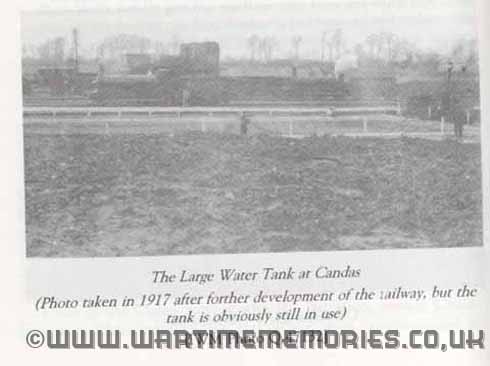
Water Tank Building on Candas-Acheux Railway.
16th Btn. Royal Irish Rifles - Pioneers.
Railway Candas to Acheux.
In addition to the ongoing work, evening entertainment was organised from 1900 to 2030. Cinematograph put in an appearance with a new programme of films each day.
The Division was able to see itself on parade when it was reviewed by King George V on Hankley Common prior to its departure from England.
Charlie Chaplin went down as a great favourite with the French children as well as the troops.
Captain Paton, now the Battalion’s Chaplain, had been sent a Pathescope from friends in Londonderry, so cinema shows became more accessible than ever. The Battalion had with it for 3 days the Ulster Divisional Troupe, The Follies (later called The Merry Mauves) and thoroughly enjoyed its performance. There was also a Battalion smoking concert and a regimental minstrel group was formed.
Railway work continued with some changes in the location of companies and responsibilities of officers.
Captain Jewell (4 Company) was responsible for the terminus at Candas, for a new diamond crossing, for maintenance of the track and for all infantry working parties in the section.
Captain Shepperd (1 Company) which now moved out of Acheux, was responsible for the section from Rosel to Punchvillers and for infantry work parties.
Captain Platt (2 Company) which moved to Acheux was responsible for all buildings, signal boxes and platforms on the line.
No.3 Company (Captain Chase) which had been on detachment moved back to Battalion Headquarters.
Lt Dolling was in charge of all petrol pumps along the line and 2/Lt Slater after completion of a survey, was responsible for all steel tanks along the line.
With the Somme decision now official, as work continued on the railway, up to two companies at a time were sent off for battle indoctrination in the trenches to prepare them for their support role in the coming offensive.
1st May 1916 Railway Activity 16th Btn. Royal Irish Rifles - Pioneers.
Railway Candas to Acheux.
The arrival of May still saw elements of the Battalion involved in railway work. New sidings and crossings were being constructed and the track was being raised and packed in marshy areas near Rosel.
Steel tanks and platforms along the route were still under construction. No.1 company from Candas to Punchevillers and No.3 Company from Punchevillers to Acheux.
Other Companies were presumably in the trenches
The work was completed on the 31st May 1916 and the Battalion was then ordered to Aveluy Wood.
Summary: Candas to Acheux Line.
- The work completed in the 5 month period is listed as follows.
- Survey and construction of 19 miles of broad gauge railway over terrain
- which included large sections of swampy ground.
- Construction of 13 ½ miles of sidings.
- Construction of two terminals at Candas (including junction with
- existing main line) and Acheux.
- Built all necessary platforms, offices, station buildings and signal
- boxes at the two main terminals and four intermediate stations.
- Built engine inspection and repair facilities.
- Built a number of steel tanks for petrol along the route.
- Constructed two cement 100,000 gallon water tanks.
- Installed numerous points and crossings throughout the system.
Starting on the 29th December 1915, the last spike was driven on the 18th February 1916. (Candas to Belle Eglise)
Opened the line to traffic on the 20th March 1916 (Candas to Belle Eglise) and completed the entire system on 31st May 1916.
This was a remarkable achievement since some of the work at Acheux was just within enemy heavy artillery range. It was reckoned at the time to be the best section of railway in the whole of France and continued in use long after the war and the decommissioning of the Battalion.
It provided an excellent tribute to the Battalion’s expertise and determination in fulfilling their task on time.
12th of June 1916 Sodden Ground 
29th of June 1916 Assault Positions 
1st July 1916 Somme Offensive The major decisions regarding the Somme offensive were made in March 1916 and all units now had new planned objectives. For the Pioneers, 16th Btn. Royal Irish Rifles it was a return to defensive work reinforcing existing wiring and trenches together with the construction of several lines of additional assembly trenches.
Whilst putting the finishing touches to the broad gauge railway, from early April small sections under the command of one officer were attached weekly to the 14th Royal Irish Rifles, 10th Royal Irish Fusiliers and the 9th Enniskillen Fusiliers giving them experience of life and working conditions at the Front Line.
Prior to the attack on the 1st July, the 16th were responsible for constructing new assembly trenches, fixing damaged wiring, deepening certain trenches and building bomb-proof dugouts along the whole front line of the 36th Ulster Division.
They also repaired and maintained an existing trench tramway and built a new tramway. These tramways operated using trolleys which needed about 6 men to push when fully loaded with ammunition, food or defence building equipment. Return journeys carried waste materials and also any casualties for treatment in rear area medical centres.
The Battalion was billeted in defensive positions in Aveluy Wood, which was only about 1500 yards from the front line and well within enemy artillery range. Indeed the battalion settled down for the first night on arrival, only to suffer an enemy bombardment around 0230 so slit trenches had to be dug hurriedly for their own protection.
All work was to be completed by the 19th June but the commencement of the bombardment was delayed for various reasons with the attack eventually set for the 1st July 1916, a day to become a source of great sorrow and pride for the people of Ulster when the outcome was eventually disclosed.
1st July 1916 Somme Offensive During the actual attack on the 1st July, the 16th Btn. Royal Irish Rifles was in active support positions to move supplies forward, cut new connecting forward trenches to the German front line trenches and generally help the advancing troops. In some areas this was successful, but lack of committed fresh troops limited success whilst in other areas enemy troops were still in possession of targets and the men had to hold defensive positions against enemy counter attacks.
The Ulster Division, having suffered about 5,500 casualties including killed and wounded, were withdrawn at 1800 that evening, but the 16th Pioneers had to work on supporting the replacement division until their eventual withdrawal on the 8th July 1916.
Prior to this month the war diaries had not reported monthly casualties but were now going to have to do so for many months to come.
Casualties at the point of relief from the Somme sector were:
2 officers killed, 3 wounded and 5 broke down (later termed shell shocked).
Among the men 22 were killed and 159 wounded of which over 100 were invalided.
At the close of the first 9 months since arrival in France, the Battalion had fully earned their distinctive emblem of the crossed rifle and pickaxe.
1st July 1916 Terrible Losses 
2nd of July 1916 A Gallant Plan 
8th July 1916 Somme to Messines 16th Btn. Royal Irish Rifles - Pioneers.
The Move to Belgium, Somme to Messines
After being relieved at the Somme on the 8th July 1916, the Battalion remained on the move for some time and was not involved in any pioneering work.
- 10th Jul Marched from Harpenville to Beauval and billeted (9½ miles).
- 11th Jul Marched from Beauval to Bernaville and billeted (9 miles).
- 12th Jul Marched to Conteville (6 miles) then by train to Theinnes (55
- miles) and marched to Blaringham and billeted (3 miles).
- 13th Jul Marched from Blaringham to Moulles and billeted (14 miles).
From the 14th to 20th July, the Battalion stayed at Moulles for interior economy (a military term for general Cleaning of a personal nature, including equipment and accommodation ).
The men were exhausted and this period was used to boost morale with exercise, games and parades to present medals awarded during recent campaign actions.
Further moves then took places as follows:
- 21st Jul Marched to Volkeringshove and billeted (6 miles).
- During this march they witnessed the explosion of an ammunition dump at
- Audvicq.
- 22nd Jul Marched to Winnezeele and billeted (16 miles).
- 23rd Jul Marched to Bauvoorde (10 miles) and camped on the Belgian
- border.
- 24th Jul Marched 3 miles to a hill position.
This was about 2 ½ miles from Bailleul where they obtained some dilapidated Armstrong huts and set up camp.
The marches were not long by modern standards but the constant moves involved a daily sequence of reveille, packing equipment and transport, having a hot meal, parading in full kit and laden transport before starting out on the march.
The full Battalion would occupy about 1000 yards of road and take about 10 minutes to pass any given point in the route. On arrival at the destination, the reverse order would be unloading, setting up camp, feeding men and animals and settling down for the night.
Exhausting as that may seem, it was not the full story as rations had to be organised. One day’s rations were carried by each man, though probably on Battalion transport, also fodder for the animals, so each day more rations had to be acquired from collection points.
For 1000 men this meant about 1 ½ tons of rations and for animals 1 ¼ tons of fodder to collect and distribute each day.
The Quartermaster had quite literally very much on his plate and everyone depended on his skill and organisational ability.
Foot inspections were considered to be a very important requirement as was the watering, grooming and feeding of the horses and mules.
10th of July 1916 Entraining Plans 
13th of July 1916 To Tilques
19th of July 1916 Reorganisation
22nd of July 1916 Orders for Line Changes 
23rd of July 1916 Relief Carried Out 
27th of July 1916 109th Brigade Enters the Line 
1st August 1916 Messines Sector - Flanders 16th Btn. Royal Irish Rifles - Pioneers.
At the end of July the 36th Ulster Division was sent back into the line and all the moves of the 16th Battalion were to bring it into support positions around Neuve Eglise opposite enemy positions on the Messines Ridge.
The Battalion had grown accustomed to the terrain in the Picardy region of France. Now they were to encounter the fairly flat low lying terrain of Flanders with its water table problems that made defensive position, road construction and maintenance methods a very different proposition.
Flanders, August 1916 to December 1916.
During August the entire 36th Division were committed to the Front and pioneering work gathered pace. Everywhere there was water just below the surface and even on the highest ground this was encountered within a few feet. Communication trenches could only be dug down a couple of feet, so construction had to be above ground by piling earthworks or sandbags to the required heights.
The war diaries describe August as being routine work but with increased enemy shelling and resultant higher casualties.
Summary as follows:
- 4th August: Several shells fell near No. 3 Company’s farm and two hit it killing all the mules and wounding the company commander’s charger. Some rifles and equipment were damaged and a fire exploded some ammunition. The men sheltered in the basement of a house until shelling was over.
- 6th August: Two companies relocated from Bulford to Le Grande Munque Farm to get closer to work. It could hold about 400 men and was about 2000 yards behind the front line.
- 7th August: Battalion HQ moved to a point south of Petit Pont and camped there.
- No.4 Coy’s work assignment moved from Subsidiary Line to Gas Trench.
- 13th August: Artillery active from both sides.
- 14th August: GOC visited trenches and expressed approval of progress.
- 19th August: A note of irritation in the war diary entry. "Without previous warning our artillery started a bombardment. The Boche retaliated killing 2 men and wounding 3 of No. 2 Company also wounding 3 men of No.3 Company, one of whom died later from his wounds.
- 23rd August: 3 NCOs and 33 men were assigned to construct emplacement for a mortar battery.
- 24th August: A sentry from No.3 Company challenged another man of No.2 Company and getting no reply, bayoneted him. The injured man was sent to hospital.
- 26/27th August: All available men in Battalion, about 300, were used to carry gas cylinders up to the front line trenches each night.
- 30/31st August: Gas attack on enemy took place at 0130 accompanied by a bombardment and a raid.
- 31st August: There was general retaliation by the enemy all day and No.1 Company was shelled on its way to the trenches. Another small gas attack on the enemy was carried out that night
Also during the month 2 officers and 44 ORs were attached to the 1st Australian Tunneling Company for work on Hill 63. This involved digging two galleries into its steep southern slope capable of holding two battalions completely safe from any form of artillery fire.
An amusing incident was reported in Colonel Leader’s Memoirs.
After he left one of the billets he had been occupying, his landlady complained to Divisional HQ that a grandfather cuckoo clock was missing. The following correspondence took place:
- HQ to Leader: Can you offer any explanation?
- Leader to HQ: No.
- HQ to Leader: The GOC desires that you answer this question more fully.
- Leader to HQ: No I can’t.
- HQ to Leader: The GOC considers your answer most impertinent. Kindly send more particulars about this cuckoo clock.
- Leader to HQ: Cuckoo; cuckoo; cuckoo.
It then transpired that the lady’s son-in-law not trusting the British had removed the clock before the colonel’s occupation.
So he sent off a final message:
Leader to HQ: Soldiers I am innocent, the cuckoo clock has been found.
Later an officer from the Division on leave met a relative of the Colonel who asked him if he knew John Leader, to which he replied: "Oh yes, everyone knows the cuckoo colonel".
Colonel Leader was suffering from injuries received when his dugout was blown in and eventually on the 8th August he allowed the Medical Officer to evacuate him to No.12 Casualty Clearing Station and he was returned to the UK.
His place as Commanding Officer was taken by Major Meares, who was promoted to Temporary Lt Colonel in September.
Casualties for August reported as:
Other Ranks 2 killed, 6 wounded and 1 died from wounds.
1st September 1916 Messines Sector - Flanders 16th Btn. Royal Irish Rifles - Pioneers.
Towards the end of August the 36th Division moved a little further north to take over from the 50th Division with its left boundary south of the Kemmel, Wytschaete Road and its right flank being the River Douve. As a result the 16th moved its HQ and numbers 2 and 4 Companies to Dranoutres.
The heat of August turned to the arrival of September and torrential rain. The new trench positions also needed extensive repairs, which were too much for a single Pioneer Battalion, so each Brigade was tasked to form labour squads and carry out repairs to their own sections. To assist in management of the work some experienced members from the 16th were attached to each work group. The Battalion’s own workload still included the full range of Wiring, Trenches, Saps, Dugouts and Screening.
When it rained (as it often did for days and weeks on end) water would still gather within the defensive lines so it was necessary to use inverted timber A-frames in upright positions at regular intervals and insert timber planks(duck-boarding)to provide reasonably dry underfoot movement throughout the trenches. Beneath the decking was a void one or two feet in depth through which the excess water could flow to outlet drains.
A small stream running through the area caused deep flooding in rainy periods all of which added to the Pioneer’s tasks which were carried out, often in full view of the German Artillery observers.
The Divisions positions were also on low lying ground with little or no cover and the enemy had a commanding view from his positions on the Messines Ridge.
Another necessary defensive measure was the need for extensive screening along roads and communication routes to protect personnel and traffic from being in full view of enemy artillery and snipers. This also helped to protect work parties after the screens were in place.
Improvements to Billets and Quarters together with the construction of Horse standings continued until the end of September.
Major Gardiner, Second in Command, was posted to 20th Bn Royal Irish Rifles in Newtownards and his place taken by Captain Allen, promoted to Major with Lt Maxwell appointed as Adjutant.
September Casualties - Other Ranks several wounded, numbers not given.
3rd of September 1916 A Gas Alarm 
8th of September 1916 Artillery Tit-for-Tat
1st Oct 1916 Messines Sector - Flanders Pioneer Work started in September for the 16th Btn. Royal Irish Rifles and continued throughout October with the weather worsening as winter progressed.
"The trenches and dugouts to begin with were not such at all in the sense in which the troops had been wont to use the names on the Ancre. The fighting trenches consisted everywhere save on the highest ground, of parapets built of sandbags filled with clay.
In places there was a parados similarly constructed, but over long stretches the men in the front line simply stood behind the wall, with no protection against the back-burst of shells. Water in this country appeared everywhere just below the surface and it was useless to dig trenches in the real sense for any other purpose than drainage. Even the communication trenches were sunk not deeper than a foot and piled high on either side with earth which made them satisfactory enough as cover from view, but very vulnerable to shellfire. These communication trenches were longer than those to which the troops had been accustomed, the approaches to the front line being much more exposed than among the folds of the Somme country.
As for dugouts, there were none. Little wooden-framed shelves in the parapets, a few "baby elephants", arched steel shelters, which if covered thickly enough with sandbags, afforded protection against the shells of field guns, served for the troops in line, while further back, for battalion HQ and forts, there were ruined farms, which often had good cellars and in the framework of which concrete structures could be hidden. It was hard for troops used to the Somme chalk to accustom their minds to the spongy nature of this soil."
"When it rained, which was not seldom, all the low lying ground was flooded. The valley of the Douve (a small stream) above all, from Wulverghem to the front line, became a muddy swamp, in which water lay in sheets. At such times, and indeed during a great part of the winter, many trenches simply could not be occupied. No adequate idea of the impression conveyed upon the mind of a man coming up north from the clean white trenches of the Somme can be obtained of all this area unless it is conceived as dirty, mournful and disconsolate; haunted by the evil stench of blue clay, and brooded over by an atmosphere of decay."
"You went into that front line and you never even took --- I don’t think I took my equipment off; and there were no dugouts in this particular part; and the only place I could stretch myself out was where someone had sandbagged a part of the parapet and they’d left a space between sandbags and you could crawl in on hands and knees and stretch yourself out. I remember that was the only place I could get down to have a rest."
October Casualties in 16th Btn. Royal Irish Rifles:
Officers 1 wounded, Other Ranks 6 wounded.
1st November 1916 Messines Sector - Flanders 16th Btn. Royal Irish Rifles - Pioneers.
November included some terrible weather with torrential rain, bitterly cold east winds and some snow. Mufflers and woollen gloves from home were eagerly sought after and leather lined jerkins were issued. Great efforts were made to equip the men’s huts with stoves and beds. A recreation and reading room was established with two fireplaces so that men returning cold and wet from work in the trenches had a place to get properly dried.
The real mud of Flanders was making any movement of equipment extremely difficult and ongoing work from October was now doubly difficult. With the heavy rains, what had until then been a friendly stream helping to drain the surrounding area, now became a deadly foe flooding dugouts and communication trenches. As a result hygiene problems were caused by the lack of natural drainage flow.
Casualties recorded:
November Nil
20th of November 1916 A Torpedo Ignored 
1st December 1916 Messines Sector - Flanders 16th Btn. Royal Irish Rifles - Pioneers.
December’s work continued as in November with the emphasis now on Mortar Emplacements, Saps and Trench Railways. Again the Division moved slightly southwards creating similar maintenance work in new areas. (Note: Saps are small trenches beyond the front line towards the enemy usually for advance listening posts)
As a relief to the heavy ongoing workload, Sundays were set aside for infantry training giving the men some respite whilst brushing up on their combat skills in case an enemy attack might take place though weather condition probably reduced its likelihood.
On the 21st December the Battalion received a most complimentary letter from the GOC. 36th (Ulster) Division expressing appreciation for work done during the four month period with special mention of joining up Calgary Avenue with the Front Line under wet and difficult conditions.
The 16th Battalion's CO also had his Adjutant issue a statement congratulating the men for their efforts in earning such recognition from the GOC. It is rather unusual that he did not sign the letter himself as most Commanding Officers would normally have done.
There is no record of how Christmas 1916 was celebrated. Money was raised in Lurgan to ensure that all the men got their Christmas pudding. One can only hope that the gap in the War Diaries implies a quiet and uneventful period.
December Casualties:
Other Ranks 2 wounded.
5th of December 1916 
1st January 1917 Railway Activity 16th Btn. Royal Irish Rifles are engaged as pioneers in preparation for the Battle of Messines
The British High Command had been wishing to launch an offensive towards the key German railhead at Roulers and so force a very significant withdrawal in the northern sector and from much of the Belgian Coast, but was restricted by lack of support from the French who maintained they were overstretched in their adjoining sector. Permission was finally given and planning for the necessary build up began.
Once again the 36th Division was to lose the services of its Pioneer Battalion as, in similar circumstances to the Somme, an improvement in the movement of supplies was paramount. So it was back to the Railways for the 16th Battalion.
Having established a reputation for railway construction, they were transferred to the X Corps area for just such work under the ADL RR, Second Army. (Assistant Director of Labour, Roads and Railways)
While they were away the pioneering work in the trenches was to be taken on by a labour battalion made up with a company from each Brigade together with 3 officers and 110 men of the 16th Battalion to help oversee the work. They were still exposed to the poor weather and enemy activity. It did not really work well and fell short of the usual standard of the Pioneer’s work.
The remainder of the Pioneers were assigned work on the 60cm railway lines from Ouderdom to Kemmel and south-east from Busseboom as well as works on the broadgauge railway lines at Ouderdom involving excavating, levelling and ditching, laying steel, packing and ballasting and making crossings and sidings.
On the 19th January 1917 a survey was commenced for a new 60cm line from Busseboom to Dickebusch.
Downshire Camp near Ouderdom was a tented area and the accommodation was much inferior to their last billets.
January 1917 Casualties:
Other ranks 2 killed and 1 wounded.
1st February 1917 Railway Activity 16th Btn. Royal Irish Rifles - Pioneers.
Work continued with the temporary labour battalion in the front line and support trenches throughout February with the rest of the Pioneers still fully occupied on the following Railway lines:
Broadgauge Railway - work continued at Ouderdom.
60cm railway line - from point L1 to a point on the Wijverhock/Vierstraat line.
60cm railway line - from Busseboom to Ouderdom.
60cm railway line - Busseboom, Brandhoek, Kemmel branch lines included.
Substantial replacements were received in manpower. In total they had an influx of 220 men from 1/5 and 2/15 London Regiments, the Bedfordshire Regiment and 20 from the Reserve Battalion Royal Irish Rifles.
Infantry training continued to be carried out, presumably on Sundays as a break from the heavy railway work.
February 1917 casualties, none recorded.
1st March 1917 Railway Activity 16th Btn. Royal Irish Rifles - Pioneers.
Work continues as in February with the temporary labour battalion fully stretched in the forward and support areas.
The Pioneers continuing Railway work took place on the following lines.
Broadgauge railway continued at Ouderdom.
60cm railway line from point L1 to a point on the Wijverhock/Vierstraat line.
60cm railway line from Busseboom to Ouderdom.
60cm railway line Busseboom, Brandhoek, Kemmel including branch lines.
A total length of 16 miles was worked on, but details are not recorded as clearly as the earlier Candas to Acheux operations. However it seems fairly safe to assume that the works were completed around mid-March.
The 16th returned to its Parent Division on the 19th March and was now back up to strength having received substantial reinforcements in February 1917, with a further 64 men arriving in March. The March intake included 40 men from the Central Training School via 7 Infantry Base Depot at Harfleur.
Casualties in the period January to March had been fairly light.
March 1917
Officers 1 wounded. Other ranks 1 wounded.
So the unit was fit and ready for its next great endeavour, the Battle of Messines.
10th Mar 1917 Pioneers at Work
1st April 1917 Messines Sector - Flanders 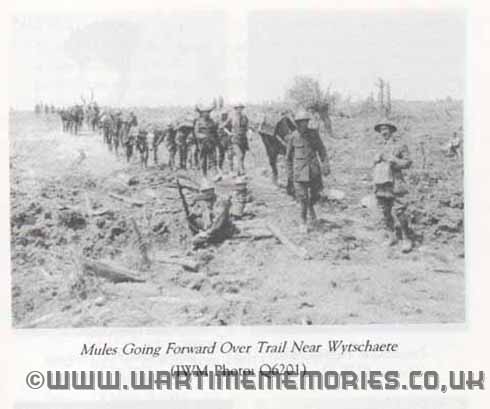
Working Party Battle of Messines Preparation
16th Btn. Royal Irish Rifles - Pioneers.
The Battle of Messines, Final Preparations April-May 1917.
The 36th Ulster Division was now facing the enemy at Messines Ridge, east of Kemmel and the 16th Pioneers were fully committed in support of them. As at the Somme this involved construction and repair of communication and assembly trenches (through which the men and equipment would move for the assault), Mortar emplacements to defend against enemy attacks and to support the assault, dugouts for headquarters and trench railways for bringing stores and ammunition forward and returning with waste materials and evacuation of casualties.
Screening was also vital, as most of the area was overlooked by the Germans in their higher positions on the Ridge. Much of the work in April was carried out in bad conditions with snow and rain making the work doubly difficult due to drainage problems and the presence of glutinous mud everywhere. Good progress was made towards the end of April as the weather conditions improved.
Battalion strength reports.
1st April 34 Officers. 868 Other ranks.
30th April 39 Officers. 866 Other ranks.
April Casualties: Other ranks - 2 killed and 4 wounded.
1st May 1917 Preparing for Attack 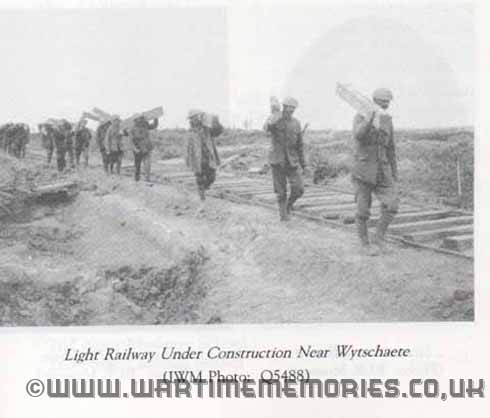
Work Party - Battle of Messines preparation.
16th Btn. Royal Irish Rifles - Pioneers report
Work which had started in April continued into May with additional areas being allocated together with more work on trench railways.
Battalion strength reports.
1st May 39 Officers. 866 Other ranks.
31st May 43 Officers. 956 Other ranks.
1st June 1917 Battle of Messines Ridge 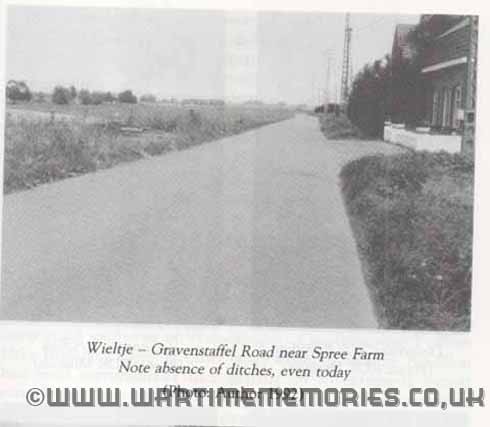
Road near Spree Farm - Battle of Langemark - Ypres
16th Btn. Royal Irish Rifles - Pioneers.
Preparations for the attack were well advanced and were to include 5 days of bombardment prior to the advance. As the ground over which the attack would take place was considerably churned up the Pioneers had prepared materials to help open roads and tracks very quickly behind the advancing troops, keeping them well supplied with essential ammunition and supplies. They were able to prepare markers for routes in advance including named signposts.
Another major surprise for the enemy was a line of mines which had been tunnelled under the German Front Line along the Messines Ridge, three of which were in front of the Ulster Division. The pioneers carried out additional work around Divisional HQ and communication trenches to the forward lines.
The Battle of Messines, June 1917
After dusk on Y, 6th June, the assault troops moved to their assembly areas and the 16th moved up to their Battle HQ. on Kemmel Hill, all in readiness for Z which was timed for 0310, 7th June. The Pioneers were to move to their forward positions the next morning.
At Z every gun on the 10 mile front opened fire and the semi-circle of mines exploded throwing debris half a mile into the air. The Pioneers reached their positions at 0630 and were given orders to proceed with their road and track clearance works at 0820.
Most of the roads and tracks were ready for wheeled traffic by dusk that evening.
At 1630 orders were given to start building communication trenches over the top of the ridge. That night over 1300 yards of trenches up to 5 feet deep were finished all signposted with previously prepared names to assist movement of relief forces in further waves of attack. On the 9th June the artillery track was finished to allow forward movement of Supporting Artillery.
The 36th Division was relieved by the 11th Division but once again the work of the Pioneers carried on givng their vital support to the new troops with the building of another 2 miles of new trench railway. The enemy had now recovered and consolidation of the newly gained positions was the order of the day. Work on the new trench railway continued between the 10th and 20th June and progressed well despite being a target for German Artillery particularly in the vicinity of L’Enfer Wood.
From the 21st to the 28th June, the Battalion was back on communication trenches and roads in the following areas.
No. 1 Company, communication trench north of Oostaverne running in a south easterly direction.
No. 2 Company, repairing and clearing road from Estaminet crossroads to In de Sterkte Cabaret.
No. 3 Company, Bob trench between Black Line and Mauve Line.
No. 4 Company, Bob trench between Mauve Line and Support Trench.
All this work was carried out at night and good progress made despite heavy enemy shelling.
During this period the Battalion was informed that on 30th June it would be transferred to the Fifth Army. Entry in war diary on 29th June was just one word "Rest!" with great emphasis on the exclamation mark.
At 0430 on 30th June the Battalion moved to new areas. Battalion HQ, 3 and 4 Companies to Watou with 1 and 2 Companies to Poperinghe.
All ranks could look back with satisfaction on the successful operations during the battle. There is little doubt that the support work by the Battalion greatly enabled the forward troops to hold on to the gains made, but in turn owed much to the meticulous preparation insisted upon by the Army Commander, General Plumer and to the achievement of tactical surprise. This would sadly not be the case in the next campaign where poor planning had a profound effect on the Battalion’s ability to provide adequate support.
Monthly Reports .
Battalion strength. 1st June, 43 Officers, 956 ORs.
30th June, 44 Officers, 930 ORs.
June Casualties. Other Ranks, 9 killed, 23 wounded.
1st of June 1917 Instructions for the Offensive 
7th of June 1917 Attack a Complete Success 
28th of July 1917 Orders for an Attack 
30th July 1917 Preparation for Langemark 
1st August 1917 Battle of Langemark
2nd of August 1917 More Orders Received 
2nd Aug 1917 Message of Congratulation 
16th of August 1917 Division Falls Back 
1st September 1917 Back to Ypres
20th September 1917 Back to Somme and Cambrai
30th of September 1917 Battle Narrative 
1st October 1917 Somme and Cambrai
1st November 1917 Battle of Cambrai 
1st December 1917 Retreat from Cambrai 
8th Dec 1917 Aeroplanes Active 9th Btn. Royal Irish Fusiliers are in trenches south of Marcoing, with heavy shelling by enemy. Enemy aeroplanes very active over our lines, flying very low. Relieved by 12th Royal Irish Rifles at 10.30pm.
Fine day.
While in front line 9th Battalion Irish Fusiliers improved trenches, made latrines, wired in front of trenches, and salved several articles of war.
The suffered five casualties to Other Ranks.
The Battalion goes into Brigade support on being relieved, less D Company who relieved the Buffs and King's Own Yorkshire Light Infantry in communication trench running north and south from front line.
9th December 1917 Daily Activity 9th Btn. (North Irish Horse) the Royal Irish Fusiliers.
South of Marcoing. Battalion in Brigade support.
10th December 1917 Daily Activity 9th Btn. (North Irish Horse) the Royal Irish Fusiliers.
South of Marcoing.
One-hundred and sixty Other Ranks and four Officers for a working party, carrying up wire to front line.
This work in assisting 16th Bn Royal Irish Rifles the Divisions Pioneer Battalion.
11th December 1917 Daily Activity 9th Btn. (North Irish Horse) the Royal Irish Fusiliers.
South of Marcoing.
Battalion in Brigade support.
There were four Officers and 100 Other Ranks on a carrying party from 1630 to 0200(12th December 1917).
12th December 1917 Daily Activity South of Marcoing 9th (North Irish Horse) Battalion, Royal Irish Fusiliers.
are in Brigade support on being relieved by 2nd Battalion Royal Irish Rifles in the line at dusk.
C Company on right. B Company on outpost line.
A Company on left. D Company in support.
13th December 1917 Daily Activity 9th Btn. (North Irish Horse) the Royal Irish Fusiliers.
South of Marcoing.
Captured a prisoner at 0430 of the 6th (Reserve Infantry Regiment). Battalion stood to at 0530 to meet a rumoured attack at 0630.
Word received from Division Headquarters at 0330 that the enemy was to attack in great force at 0630. No attack however took place.
14th December 1917 Daily Activity 9th Btn. (North Irish Horse) the Royal Irish Fusiliers.
South of Marcoing.
Battalion in the line. Two Other Ranks casualties.
15th December 1917 Daily Activity 9th Btn. (North Irish Horse) the Royal Irish Fusiliers.
are
South of Marcoing.
Battalion is in the line. D Company relieved B Company in the outpost line.
One Officer 2nd Lieutenant Bray and three Other Ranks casualties.
16th Dec 1917 Post Stormed 9th (North Irish Horse) Btn., Royal Irish Fusiliers.
report from
South of Marcoing:
German post stormed by our patrol at 1700 with Gunner bayoneted and machine gun captured. His identification secured (6th Division Reserve Infantry Regiment).
Lieutenant Caulfield, 7th Somersets, buried by our Battalion.
Trench very much improved and more wire put out.
Relieved by 7th Royal Fusiliers at 2100 and marched to Metz.
Fifty rifles salved and several thousand rounds of small arms ammunition, also boxes of grenades salved, cleaned and put under cover.
17th December 1917 Daily Activity 9th Btn. (North Irish Horse) the Royal Irish Fusiliers.
Metz-le-Coutre.
Left Metz at 1200 for Etricourt. Billeted in tents at Etricourt.
18th December 1917 move to Mezieres
18th December 1917 Daily Activity 9th Btn. (North Irish Horse) the Royal Irish Fusiliers.
Etricourt.
Entrained at Etricourt for Mondicourt. Detrained at Mondicourt and marched through deep snow to our billets in the village of Coullemont.
The heavy snow delayed our transport, which did not arrive till midnight.
1st January 1918 Mezieres and Grand Seracourt - defensive preparations 16th Btn. Royal Irish Rifles - Pioneers.
The Battalion left its billets at 0330 on the 29th December and entrained at 0900 in Monticourt. It detrained in Moreuil (44 miles) and marched to Mezieres (2 miles).
The 30th December was a rest day and on the 31st December the Transport section, which had travelled by road, arrived.
Whilst resting from pioneering work, infantry training took place from 1st to 5th January with 100 men leaving as replacements to other Royal Irish Rifles Battalions.
(50 to 15th RIR, and 25 each to 14th and 10th RIR).
99 men of B1 Status arrived as replacements, B1 meaning fit for manual work but not for front line combat.
On the 7th January the Battalion moved to Caix (5 miles) for infantry training from 8th to 11th January and then on 12th Jan. to Campion (7 miles) with rest on 13th Jan.
On 14th January they moved to dugouts north of Grand Seracourt (19 miles) followed by two days bathing. All these moves were in conjunction with the gradual takeover of French positions by the 36th Division.
Naturally the tasks that followed were to strengthen and improve defensive positions for the 6000 yards front which the Division had to control in a southwards direction to St. Quentin. The first task was road repairs in St Simon which took from 17th to 18th Jan. for 1 and 2 companies. On the 19th Jan. HQ moved to Grand Seracourt and work commenced on widening and deepening trenches which had been poorly constructed by the French.
The companies were employed from the 19th to the 31st Jan. on the following work:
1 and 2 Companies at L’Epine de Dallon.
3 Company at Boyeau de Station.
4 Company at Boyeau de Contescourt.
Battalion Strength - January 1918
Jan 1st Officers 43 Other ranks 903
Jan 31st Officers 43 Other ranks 879
Casualties Other rank 1 died from wounds.
27th January 1918 Daily Activity 9th Btn. (North Irish Horse) the Royal Irish Fusiliers.
At 1000 the Divisional Commander presented ribbons of decoration awarded from the recent operations at Moeuvres.
At 1400. Beat 16 Royal Irish Rifles at football, 5 goals to 1.
1st February 1918 Grand Seracourt - defensive work 16th Btn. Royal Irish Rifles - Pioneers.
From the 1st to 22nd February work was allocated as follows:
1 Company Contescourt Alley Communication trench, deepening and widening to 8 feet deep, 6feet wide at top and 3feet wide at bottom with trench boards laid and dugouts constructed.
2 and 4 Companies, the construction of a strong point at L’Epine de Dallon.
3 Company Station Alley Communication trench to be deepened and widened to same dimensions as Contescourt and trench boards laid.
There were some moves during this period for similar work at Jeanne d’Arc strong point.
On the 23rd February work commenced on a series of strong points in the forward zone at Jeanne d’Arc, Grugies and Boadicea.
On the 24th February Battalions were reduced from 4 to 3 companies and Brigades from 4 Battalions to 3. This change of establishment worked well for the Pioneers as 4 company personnel were distributed between the other 3 companies, but the Infantry Brigades were less fortunate as the surplus battalions were removed from their brigades and formed into Entrenchment Units and thus separated from those they had fought alongside.
Battalion Strength February 1918
1st Feb. Officers 43 Other ranks 890
28th Feb. Officers 43 Other ranks 898
Casualties No casualties reported.
15th of February 1918 An Anticipated Attack
1st March 1918 Grand Seracourt - defensive work 16th Btn. Royal Irish Rifles - Pioneers.
(Guidance note next page is on 21st March 1918.)
March 1st to 20th. Work continued on defensive dugouts and strong points as follows:
1 Company - dugouts at Gaugies and Boadicea.
2 Company - wiring and construction of elephant shelters at Boadicea.
3 Company - wiring and construction of elephant shelters at Jeanne d’Arc and wiring at Giffecourt.
The Allied High Command had knowledge of an imminent German offensive but no idea of when and where it might take place hence the concentrated efforts to improve defences to counter any such action.
1st March 1918 Daily Activity 9th Btn. (North Irish Horse) the Royal Irish Fusiliers.
Grand Seraucourt.
1730. Battalion moved to support at Essigny Station in relief of 1st Royal Irish Fusiliers.
2nd March 1918 Daily Activity 9th Btn. (North Irish Horse) the Royal Irish Fusiliers.
2 March Essigny Station.
Working on defences of Battle Zone daily until 7th March
- Effective strength: Officers 46, Other Ranks 1083, horses 36, mules 16.
- Decrease: Captain J Grant (Medical Board, England).
- Increase: Twelve Other Ranks.
7th March 1918 Daily Activity 9th Btn. (North Irish Horse) the Royal Irish Fusiliers.
1800. Relieved 1st Royal Irish Fusiliers in line, with 2nd Royal Irish Rifles on left and 8 King's Royal Rifles on right.
9th March 1918 Daily Activity 9th Btn. (North Irish Horse) the Royal Irish Fusiliers.
9 March - Patrolling and wiring nightly until 14th March.
Our artillery lively cutting enemy wire and sweeping likely places of assembly for enemy attack. Enemy artillery unusually quiet. Great aerial activity owing to fine weather and visibility. One enemy aircraft brought down on enemy line opposite left Battalion front.
1500 9th March Enemy machine gun captured without opposition by 2nd Lieutenant W.G Greenaway and three Other Ranks from position at B.17.a.9.8.
Effective strength: Officers 46, Other Ranks 1076, horses 36, mules 16. Decrease: Seven Other Ranks.
14th March 1918 Daily Activity 9th Btn. (North Irish Horse) the Royal Irish Fusiliers.
2000. Relieved by 12th Royal Irish Rifles and moved to Grand Seraucourt in reserve.
16th March 1918 Daily Activity 9th Btn. (North Irish Horse) the Royal Irish Fusiliers.
- Effective strength: Officers 45, Other Ranks 1058, horses 37, mules 18.
- Increase: Horses 1, mules 2.
- Decrease: Officer 1, 2nd Lieutenant W.G Greenaway transferred to Royal Flying Corps, England; Other Ranks 18.
17th March 1918 Daily Activity 9th Btn. (North Irish Horse) the Royal Irish Fusiliers.
Grand Seraucourt.
St Patrick's Day. Sunday. Church Parade in morning and sports in evening.
18th March 1918 Daily Activity 9th Btn. (North Irish Horse) the Royal Irish Fusiliers.
18-20 March 1918
Intensive training, by Platoons, in morning. Specialist training in evening.
21st March 1918 German Offensive 1918 16th Btn. Royal Irish Rifles - Pioneers.
All the recent work of the Pioneers was to no avail as the decisive enemy attack launched on the 21st March overran the flanks of the 36th Division leaving the continued defence of their positions both untenable and pointless. A disorganised retreat to the old 1916 defensive lines took place over a ten day period.
The 36th division retained its cohesion in the retreat which was very difficult over open and exposed areas in full view of the enemy. The recent infantry training which the pioneers had received now came to their assistance as they were attached to the 9th Battalion Royal Irish Fusiliers and fought beside them in defensive positions during the retreat. They eventually reached safety and were evacuated to Gamaches on the Normandy coast.
The severity of battalion losses are shown by the end of March statistics
Battalion strength, March 1918.
1st Mar Officers 43 Other ranks 819
31st Mar Officers 20 Other ranks 449
Showing a loss of 23 officers and 370 other ranks.
These figures include a total of 9 officers and 150 men missing at the Jeanne d’Arc Redoubts with, presumably many captured.
It is also known that a further 9 officers and 28 men were killed leaving a total of 5 officers and 192 men who fell during the retreat.
- March Casualties.
- Killed Officers 1 Other ranks 25
- Died from wounds Officers 1 Other ranks 2
- Wounded Officers 7 Other ranks (not reported)
- Missing Officers 10 Other ranks 150
- Balance unaccounted Officers 4 Other ranks 193
- Overall Officers 23 Other ranks 370
Summary of Battalion Activity from 21st to 31st March 1918.
The Battalion was divided into two groups during the fighting retreat.
Group A under the command of Major WJ Allen.
Group B under the command of Captain J maxwell.
In 10 days, a total of 240 hours the men in A Group had been involved for at least 112 hours in activities demanding intense physical effort and emotional stress.
The figure for B Group was 114 hours.
The following is an account of the daily activities during the retreat from 21, 31 March showing how intense the activity was at times.
Over 10 days in a total of 240 hrs:
Group A 112 hours actively involved.
Group B 114 hours actively involved.
16 Bn Royal Irish Rifles(P) in 1918 Retreat - Details as follows:
| Date | Hours | Location | Function |
| Mar21 | 3 | NW Gd Seracourt | Move to RV
|
| | 1 | RV | Move St Simon
|
| | 4 | | Working there
|
| 21/22 | 1 | St Simon | Move Ollezy(night) |
| Mar22 | 1 | Ollezy | Move to Estouilly |
| | 9 | Move to Eaucourt | Sommette and Work |
| Mar23 | 12 | Eau-Sommette | Fighting with 9RIrF |
| 23/24 | 6 | Sommette to Villeselve | Fighting withdrawal |
| Mar24 | 22 | Villeselve | Fighting |
| 24/25 | 4 | Villeselve via Guiscard | Move by night to Bealieu |
| Mar25 | 5 | Beaulieu via Avricourt | Move to Warsy |
| Mar26 | 1 | Warsy |
| | 9 | Erches-Bouchoir | Move into trenches |
| Mar27 | 8 | Erches-Bouchoir | Fighting in trenches |
| | 4 | Arvillers | A Group position |
| | 15 | Arvillers | B Group position |
| | 4 | Arvillers, Sourdon | Move A Group |
| 28Mar | 1 | Arvillers | Fighting B Group |
| | 4 | Arvillers, Sourdon | Move B Group |
| | 10 | Coullemelle | Move and work A Group |
| Mar29 | 1 | Sourdon, Chaussoy | Move B Group |
| Mar30 | 8 | Saleux via Velennes | Move A Group |
| | 8 | | Move B Group |
The Battalion arrived in Gamaches on the Normandy coast by the 31st March and were in a very sorry state after all their constructive efforts followed by the devastating German attack and the hardship endured physically in the subsequent retreat together with the emotional stress of witnessing the loss of so many friends and colleagues.
Yet more reverses were to be encountered further testing the resolve of the 16th (Service) Battalion, the Royal Irish Rifles (Pioneers) before the long path to peace in late 1918.
21st March 1918 Start of German Offensive. At 2am. 9th Btn. (North Irish Horse) Royal Irish Fusiliers
report "Intensive enemy barrage opened on our positions, for a depth of from 4 to 6 kilometres."
At 0600 enemy attacked and Battalion moved to Brigade Headquarters just east of village.
- 2nd Lieutenant Prenter and four Other Ranks killed.
- 2nd Lieutenant Perkins and 16 Platoon missing.
- Part of 2 Platoons of A Company missing.
22nd March 1918 9th Btn. (North Irish Horse) the Royal Irish Fusiliers
fell back on Halpincourt, where we remained during the day, falling back on Ollizey in the evening.
24th March 1918 Daily Activity 9th Btn. (North Irish Horse) the Royal Irish Fusiliers.
Remained at Fleuesle for the day, and fell back on Guiscard, remaining there for the night.
Captain Partridge MC killed and Captain Vesey MC wounded during night.
25th March 1918 Daily Activity 9th Btn. (North Irish Horse) the Royal Irish Fusiliers.
25-26 March 1918
Fell back through Busse to Avrilcourt and then marched via Tilloloy, Popincourt, Grivillers, Marquivillers, Guerbigny to Erches, arriving at 1100 on morning of 26th. Lewis Guns were sent by lorry previous night.
Major Brew and details went into line in front of Erches.
Remainder of Battalion under Captain Despard MC formed reserves west of Erches.
27th March 1918 Enemy Attack The enemy attacked and the Royal Irish Rifles fell back on 9th Battalion Royal Irish Fusiliers in reserve, who fell back with same to a position south of Arvillers, and then south of the village, where they remained the night.
28th March 1918 Daily Activity 9th Btn. (North Irish Horse) the Royal Irish Fusiliers.
This party under Captains Despard, Crosbie and Dean, and 2nd Lieutenant Davison, fell back, by orders, through Hangesy-en-Santerre, Plessier, Rosainvillers, Moreuil, Mailly-Raineval, Sourdon, remaining there the night.
29th March 1918 Daily Activity 9th Btn. (North Irish Horse) the Royal Irish Fusiliers.
Marched from Sourdon, via Ailly-sur-Noye, Jumel to Taisnil.
30th March 1918 Daily Activity 9th Btn. (North Irish Horse) the Royal Irish Fusiliers.
Marched from Taisnil to Sauleul [Salouël] and remained the night.
31st March 1918 Daily Activity 9th Btn. (North Irish Horse) the Royal Irish Fusiliers.
Entrained from Sauleux [Saleux] to Eu and marched to St Quentain-le-Mott.
31st of March 1918 Account of Operations 
1st April 1918 Relocations 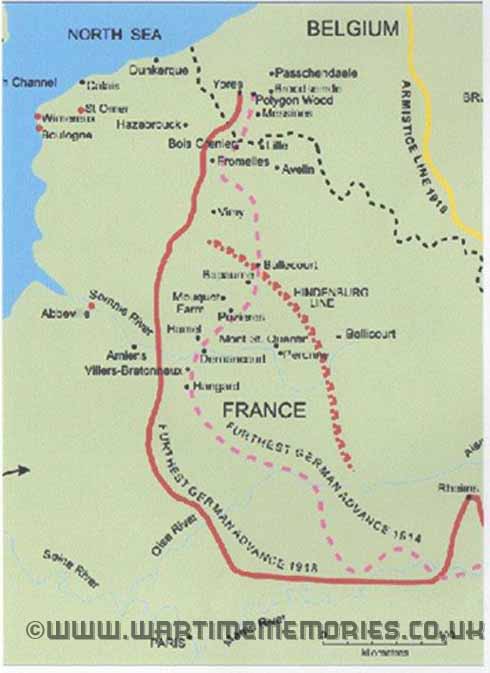
German positions in April 1918
16th Btn. Royal Irish Rifles - Pioneers.
Ypres and St Jans Capel.
On the 1st April the Battalion arrived by train at Gamaches about 7 ½ miles from the Normandy coast and marched about 5 miles towards the coast to billets at Oust Marest. The transport moved by road. The next 2 days were spent on rest and bathing.
The 36th Ulster Division were needed back in the Ypres area and on the 4th April the Pioneers moved to Eu (2 miles) and entrained for an overnight journey to Rexpoede, close to the Belgian frontier about 13 miles north west of Poperinghe. Arriving at 0500 they then moved by lorry to Brake Camp and then on 7th April to Turco Camp with transport moving to Murat Camp. The next two days were spent on refitting and infantry training. Refitting was a term covering reissue of equipment lost in the retreat and some reinforcements, though only about 49 at this stage, who would need training in pioneering skills. A larger draft of some 300 men arrived on the 12/13 April keeping Officers and Senior NCOs busy allocating them to companies and absorbing them into Battalion training on the 14th April.
The German offensive still continued to make progress and several more divisional moves took place to defend remaining areas still in Allied hands. The divisional withdrawals continued to more defensive positions on 15th April and the next week was fairly quiet. The Germans had recaptured Mount Kemmel and some surrounding areas but had not threatened Ypres and other high ground around Mount Kemmel were still held providing some advantage.
A plan showing the limit of the German advance at this stage of the war is available from this page.
Battalion strength 1 April Officers 20 ORs 449
30 April Officers 33 ORs 943
Casualties April 1918
Killed/Died of Wounds Officers nil ORs 12
Wounded Officers nil ORs 7
5th of April 1918 Command of the Line 
14th of April 1918 A Withdrawal 
1st May 1918 Ypres and St Jan Capel Sector 16th Btn. Royal Irish Rifles - Pioneers.
On the 1st of May the Battalion was located as follows:
HQ and No.3 Company at Caribou Camp.
Nos. 1 and 2 Companies at Some Camp.
The whole of May was taken up with preparations to resist further German advances so defence works in considerable depth were commenced. This involved dismantling what were previously rest camps in rear areas but now part of the battle zone, and storing materials for use elsewhere. So No.1 Company continued defence work around Brielen while No.2 Company were dismantling huts at Siege Camp and No. 3 Company was repairing Rum and Allen tracks from Canal Bank to the Vlamintinghe- Elverdinghe Line as well as dismantling huts at Siege Junction.
From 16th to 18th May No.3 Company was engaged in wiring near Siege Camp. On the 19th it went back to Rum and Allen tracks to strengthen bridges for artillery to cross also a platoon to dismantle huts near Canal Bank north of Ypres.
On the 28th May No. 2 Company started work on a new defence line for Vlamertinghe to Elverdinghe as well as helping No. 3 Company.
The month ended with the companies still on these tasks. Training was also carried out on Lewis gun, Signalling and Wiring with some courses attended at Army and Corps Training Schools.
Battalion Strength:
1st May Officers 33 ORs 943
31st May Officers 34 ORs 1030
Casualties None Reported.
17th of May 1918 Harassing Fire 
23rd of May 1918 Quiet Day 
1st June 1918 Recuperation and Training 16th Btn. Royal Irish Rifles - Pioneers.
For the first three days these tasks continued. On the 3rd June 36 Division was placed in II Corps Reserve and the 16th Pioneers moved to the west of Poperinghe. For the Division it was a month of recuperation and training of young replacement soldiers.
The Division had also to provide labour for defensive works consisting of 1/3rd infantry and 2/3rd pioneers. Defence in depth was formidable with 4 lines between Ypres and Poperinghe each six miles apart (Brielen, Green, Yellow and Blue Lines).
The Battalion work and training lists for June 1918.
| Date | Green | Blue | Training |
| 5, 8 | 2 Coy. | 1 Coy. | 3 Coy. |
| 9 | Sunday, no work |
| 10, 12 | 3 Coy. | 3 Coy. | 1 and 2 Coys. |
| 13 | 1 Coy. | 2 Coy. | 3 Coy. |
| 14, 15 | | 1 and 2 Coys. | 3 Coy. |
| 16 | Sunday, no work |
| 17, 22 | | 1 and 2 Coys. | 3 Coy. |
23 | Sunday, no work |
| 24, 25 | | 1 and 2 Coys. | 3 Coy. |
| 26, 30 | | 1 and 3 Coys. | 2 Coy. |
| 1, 2 July | | 1 and 3 Coys. | 2 Coy. |
Green line was already well advanced hence little work needed in June. A lot of this was breastwork (sandbags or earthworks) due to the high water table with the nearby waterways.
Blue line needed a lot more work with beehive shelters and clearing a 300 yard field of fire area in front together with wiring.
Training carried out was infantry training of all types with emphasis on Lewis gun and musketry.
Battalion Statistics
1 June Officers 32 ORs 1034
30 June Officers 32 ORs 1087
Casualties one unexplained OR casualty as no contact with enemy reported.
1st July 1918 St Jans Capel Sector 16th Btn. Royal Irish Rifles - Pioneers.
St Jans Capel Sector.
Having completed a lot of defensive preparation as usual an unexpected move took place for the Division with a move to take over French positions further to the South.
The Division was moved into reserve behind the French XVI Corps before taking over from the French 41st Division on the outskirts of Bailleul and the 16th moved into billets in the vicinity of St Sylvestre Cappel.
From the 4th to 6t July was spent in billet inspections, infantry training and specialist training on Lewis gun, signalling and bombing.
On the 7th the Battalion moved to the St Jans Capel sector and half of Companies 2 and 3 were moved into billets south east of Mont des Cals.
Work from 8th to 18th July was as follows:
- No.1 Company, Infantry training which it had missed during June.
- No.2 Company Forward Half, Communication tranches and wiring.
- No.2 Company Rear Half, Infantry training.
- No.3 Company Forward Half, also in support area on dugouts, deepening
- and revetting trenches, completing Machine Gun Emplacement and Wiring.
- No.3 Company Rear Half, Infantry training.
Work continued in other locations until the 29th July.
On the night of 23/24th July posts at Mont Noir were shelled (gas) resulting in 1 officer and 28 other ranks being wounded. No.1 Company working in the forward area was also shelled.
Battalion strength:
- 1st July Officers 32 ORs 1087
- 31st July Officers 33 ORs 1054
- Officers Killed nil wounded 2
- Other ranks Killed nil Wounded 35
1st August 1918 Striking Back at the enemy 16th Btn. Royal Irish Rifles - Pioneers.
St Jans Capel.
Work continued in the St Jans Capel sector into August.
No.1 Company was detailed with maintenance and repairs of the following roads:
Fontaine, Berthen, Berthen, Schaexken, Rossignol, Piebrouk, Piebrouk, Berthen and Staines House roads.
No.3 Company was tasked with constructing mined dugouts near Rossignol, for the Medical Dressing Station and Brigade HQ. It was also responsible for deepening, duck-boarding and wiring trenches as part of Blue Line. These tasks continued with a number of variations until 21st August.
By now the German offensive seemed to have ground to a halt and indeed great Allied offensives had been launched further south. Employing tanks and with long sought after Artillery superiority Rawlinsons 4th British Army together with the First French Army commenced an offensive along the Amiens, Roye road with advances being made in the area of Chateau Thierry. The First and Third British Armies were driving across the old Somme battlegrounds and again approaching the Hindenburg Line.
The turning point for the Second Army at the St Jans Capel sector to go on the offensive had now been reached.
The 9th Division had captured Meteren and then the Hoegenecker Ridge south east of Meteren which left the Germans facing the 36th Division in a precarious salient which the Division proposed to push in thus shortening their own defensive line. On the night of 21-22 August the 16th Pioneers were to support an action by the 15th Bn Royal Irish Rifles to straighten the line by the capture of Mural and Wirral Farms. They were to erect a single wire fence in front of newly captured ground. During this they were involved in some fighting and captured an enemy machine gun. Only about 2/3rd of the work was completed and casualties were 8 other ranks wounded. The following night the companies were back on their tasks again.
On the 23-24th Nos. 1 and 3 Companies were employed to construct a new front line trench. Casualties were 2 other ranks killed and 3 wounded. Work continued on the night 24/25 August with about 1 mile of trenches completed. The left Brigade attacking with 1st and 9th battalions the Royal Irish Fusiliers advanced the line to the Haegedoorne, Dranontre Road on the 24th August, so on the night of 25, 26th another 500 yards of new trenches were dug and over the next two nights a further 1500 yards were completed.
On the morning of the 30th August the 36th Division were to be relieved by the 35th Division but this did not take place as the Germans withdrew from the salient overnight and lit up the night sky with the burning of their equipment as they withdrew. So the 36th had to stay in touch with the active and aggressive pursuit of the enemy. On the 31st of August the pioneers were unsurprisingly opening and repairing roads to keep up with the advance.
Battalion strength
1st August Officers 33 ORs 1048
31st August Officers 36 ORs 1022
Casualties
Officers Killed 1 Wounded 10
Other Ranks Killed nil Wounded 10
22nd of August 1918 22 POWs Captured 
31st of August 1918 British Take Mount Kemmel 
1st September 1918 The Final Advance 16th Btn. Royal Irish Rifles - Pioneers.
Although they did not know it at the time, road work was to be the principle task for the Pioneers from now until the end of the war. The great advances that took place released a flood of vehicles onto badly damaged roads and the heavy rain which followed taxed the effort of the men severely.
Continuing the road works started on the 31st August the battalion was assigned the following additional tasks
4th September Bailleul, Ravelsburg road as far as Crucifix Corner
7th September Crucifix Corner to Nueve Eglise
12th September Keersebrom towards Bailleul passing Magilligan Camp.
In order to get closer to its work the Battalion moved close to Crucifix Corner and
dug itself in on banks and fields with heavy rain creating the need for drains and culverts. The weather improved on the 15th and work progress improved until the 19th when the division was finally relieved and on the night of 19, 20th September the 16th Battalion were moved to billet in empty houses at Godewaersvelde.
The Final Advance.
The plan was for a combined British, Belgian and French force, under the supreme command of the King of the Belgians to ensure coordination, was to launch a massive offensive in Flanders from Voormezeele northwards. The 36th Division was required so the 16th Pioneers found themselves back on familiar ground for the third time but in vastly different circumstances.
Secretly and by night the 36th were moved into an area west of Ypres. The 16th having arrived at Godewaeresvelde on the 19/20th September, spent the next two days resting and cleaning equipment for the expected advance. On the 21/22nd they moved to huts and tents at Shrine Camp near Houtquerque about 6 miles northwest of Poperinghe. Once again resting and cleaning. On the 23rd the Battalion moved to nissen huts about a mile from Proven along the road to Poperinghe and Transport moved to a camp about 500 yards away. The day was spent putting up huts from salvaged materials.
Next day work started on huts in Courthove and Middlesex Camps, followed by training and removal of screening. Work carried on during 25th and 26th but the men bathed and had clothing fumigated in rotation with the works.
The attack commenced on the 28th September. The 36th Division were in reserve, but the battle went so well that they received orders at about 1100 to move forward overnight to carry the attack to the enemy the next day. The Pioneers received orders to move as well and arrived at about midnight in Ypres where they slept in derelict buildings awakening in the morning covered in a layer of snow.
On the 29th September the Brigades battled forward in driving rain and the roads were in a terrible state so most of the 30th September for the pioneers was back to road repairs in the vicinity of Black Water Corner.
September had no casualties but 20 men were transferred to the 2nd Battalion Royal Irish Rifles.
Battalion strength:
1st September Officers 36 ORs 1022
30th September Officers 37 ORs 1002
Private Thomas Neill Martin 16/124 was transferred back to the UK and assigned to the Labour Corps (Service No. 648737) due to either illness or being wounded having served to this point from the first enlisted batch of recruits in November 1914 in Lurgan.
1st October 1918 Keeping forward momentum 16th Btn. Royal Irish Rifles - Pioneers.
From the initial advance of the Army the roads were jammed with traffic and on the night of 30th September a Captain Walker is quoted as follows regarding the Zonnebeke Road
"I had never previously realised the number and variety of vehicles which move in support of three Divisions; indeed I think this road fed only the 9th and 36th Divisions (Note: This supposition is correct). There were limbers by the scores with rations; there were GS wagons with forage for the battalion transports forward; there were R.E. wagons, mess carts, guns and ammunition; there were lorries stuck in shell holes in the road and the cause of most of the trouble. On every bit of ground bordering the road were French cavalrymen. The surface and the language were equally bad and there was mud everywhere. I had to wind my way through these troubles for several miles. During my journey there was practically no movement of traffic"
Little wonder that from the 1st October the Pioneers were tasked with this very road from Zonnebeke to Becleare as the road had been bombed around midnight by a single Gotha aircraft. The Battalion also had to send 60 men to help as stretcher bearers for 108th Field Ambulance Brigade.
On the 4th October No.2 Company worked on the road from Beclaere southwards and on the night 4/5th 1 and 3 Companies wired about 1200 yards of front line trenches. They were shelled as they left the work and Lt. Dunwoody was killed with 4 other ranks wounded.
This is an account by one of the participants in the above operation:
"We were in bivouacs, a big tarpaulin, and a dozen of us were sleeping in this place. This night we went up to the front line, there were no trenches really, the Germans were retreating and I suppose were where our fellows had dug in, I think, in the dark --- I remember I drew iron stakes (screw pickets) and some fellow had got barbed wire: and we went along to some place in the dark, we didn’t know where we were. And they must have lined us up, and --- I must have screwed my stakes in. It seemed to be quiet and I was standing there and no one was coming near me, I was expecting fellows to come up with barbed wire you know --- and I was all alone there, nobody about, and I started to move sideways to get in touch with someone, quite dark of course, and I saw movement and I stooped down and here was Second Lieutenant Dunwoody down in a hole and I heard him say ‘Who shot Corporal Smith?’ and I discovered there was a lance corporal standing there and he told me that some fellow had got wounded, he’d been shot in the leg and they didn’t think he could carry on ---"
"--- Now there was a wee wayside cottage there, facing onto the road, which seemed to be parallel to where we were putting our wire up and I remember finding another hole and getting down into it. I could see the gable end of this cottage and all our fellows standing there and moving about and while I was sitting there this old machine gun opened up and was hitting the side of the roof of this cottage and I could feel the tiles coming down on the top of my head. However I was alright and I was watching these fellows and they moved on to the road: so I got up and followed them and got on to the road, and they were moving away. I don’t remember speaking to anyone but I was moving too: and suddenly the Germans, who must have had the area nicely targeted, shelled it like anything, and, there was no cover, there were no ditches or anything, there was just the stony country road. I remember throwing myself down flat on the field trying to squeeze myself into the earth. Stuff was flying all over, bits of shrapnel whizzing around, and some fellow got hit and he was shouting out and crying like anything. It eventually stopped and we all got up. I remember that --- we decided he (the wounded man) had been wounded in the face, and I was peering in the dark trying to see what his face looked like and some fellow came along and snapped ‘Leave him alone’, must have been all nerves and excited. However we must have pulled ourselves together and moved off so we got back to our bivouac place and got in and settled down, twelve of us like sardines, and somebody stuck their head in under this tarp(aulin) and said ‘Boys, Dunwoody has been killed’. And the poor fellow, a piece of shrapnel had just hit him in the head and we didn’t know. He was a nice big, boy-scout type of fellow. Just two other fellows had been wounded, the one who had been shot in the leg and the other who had been hit in the face."
Transport moved to Potijze that same night to be nearer advancing work areas.
No. 2 Company continued on the 5th October while 1 and 2 Companies rested after the overnight work. The next night both companies had to send 50 men to help bringing ammunition forward to the Front. 1 NCO was killed and 2 men wounded.
All companies were back on road works from 6th to 12th October with the road from Beclaere to Dadizele becoming very important to maintaining the now rapid advances. The paved road was made good as far as Terhand.
On the night of 12/13th parties from each company staked out lines for the next infantry attack and the following night the whole Battalion along with 122 field company R.E. were employed in digging a 3 foot deep by 2 ½ foot wide jumping off trench. Enemy machine gun fire caused two men wounded, one of which died later from his wounds. These trenches were occupied at 0200 on the 14th by 107 Brigade on the right and 109 Brigade on the left ready for the attack which commenced at 0535.
The Division attack was directed towards the town of Heule and the Pioneers were involved in several moves to keep up with them and clear/repair roads.
On the 16th and 17th the Battalion had to undertake the gruesome task of burials. It had to work its way from the Ledeghem, Menin railway line through the area which had been fought over, burying British and German dead in temporary graves for later internment in official war cemeteries. On the 17th October two members of the band were wounded at the billets by an aircraft bomb.
On the 19/20th October the 9th Bn Royal Inniskilling Fusiliers crossed the river Lys and a bridgehead was formed served by a pontoon bridge, a trellis bridge and a good permanent footbridge. No. 2 company remained on road works while 1and 3 companies moved up to help the Royal Engineers with bridge building operations. This work was so important that they were occupied in this role for the next 4 days.
The programme was:
22nd Oct. 1 and 3 Companies Bridging, HQ and 2 Company. Bathed and changed clothes also preparing clothes for the other companies.
23rd Oct. 1 and 2 Companies Bridging, 3 Company on roadworks, HQ transport and QM stores relocated.
24th Oct. 1 Company Assist RE bridging, 2 and 3 Companies Roads repairs.
25th Oct. 1 and 3 Companies Repairing roads, 3 Company Approaches to bridges.
26th Oct. work as on 25th continued.






